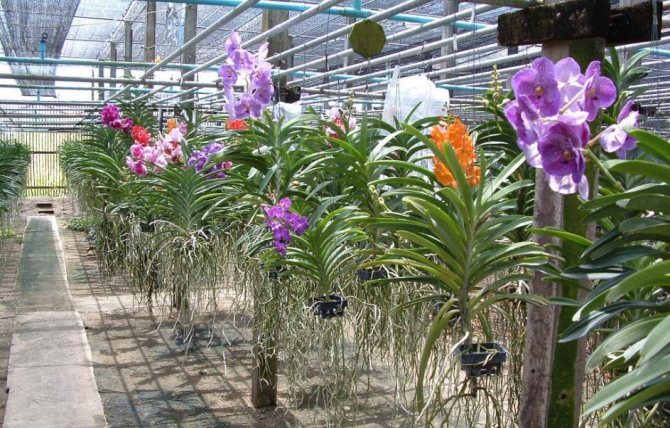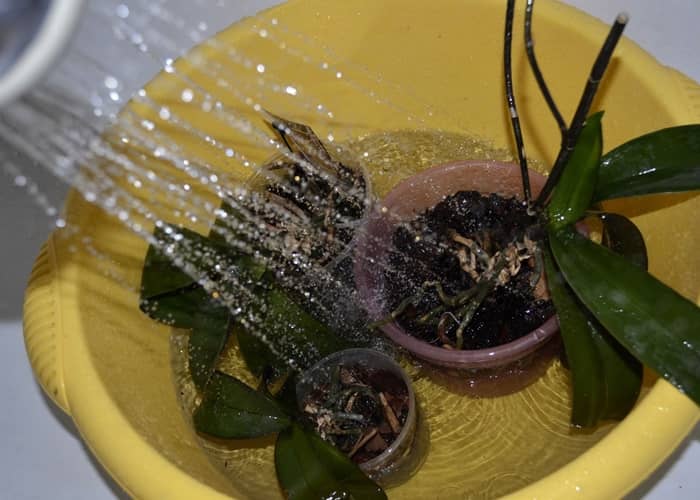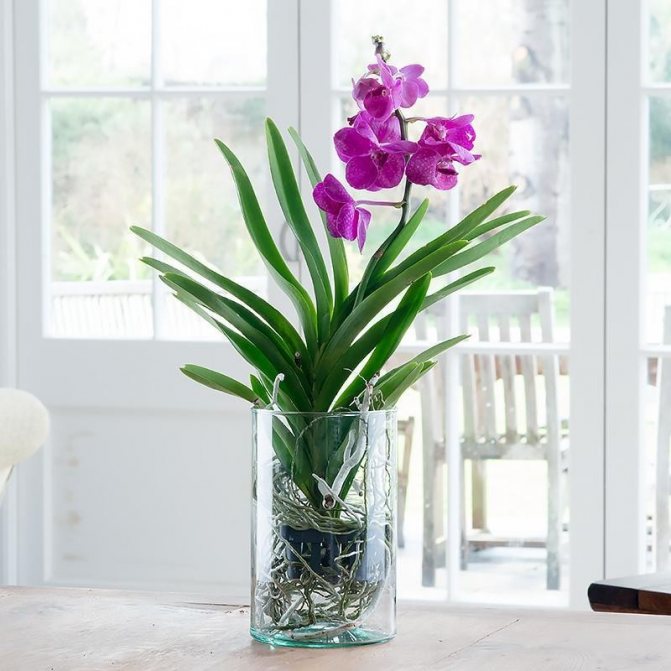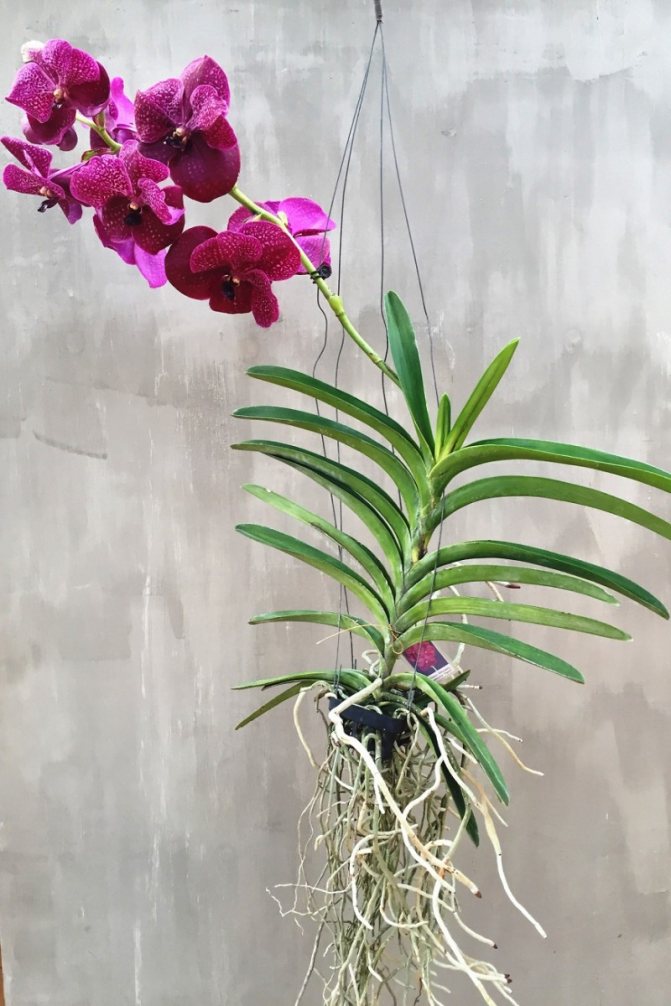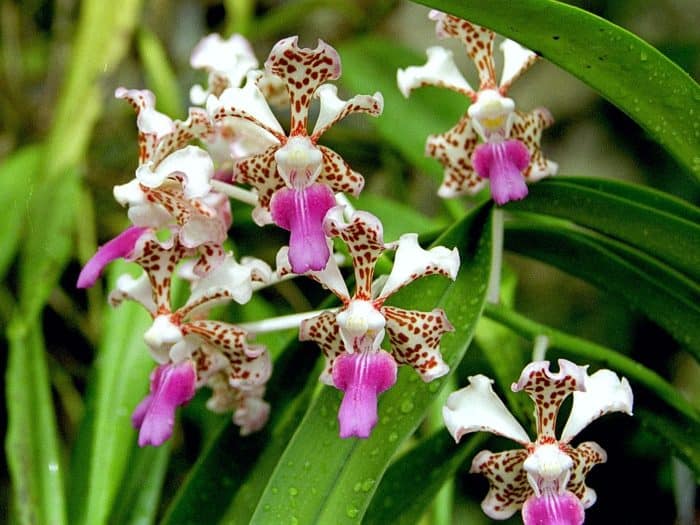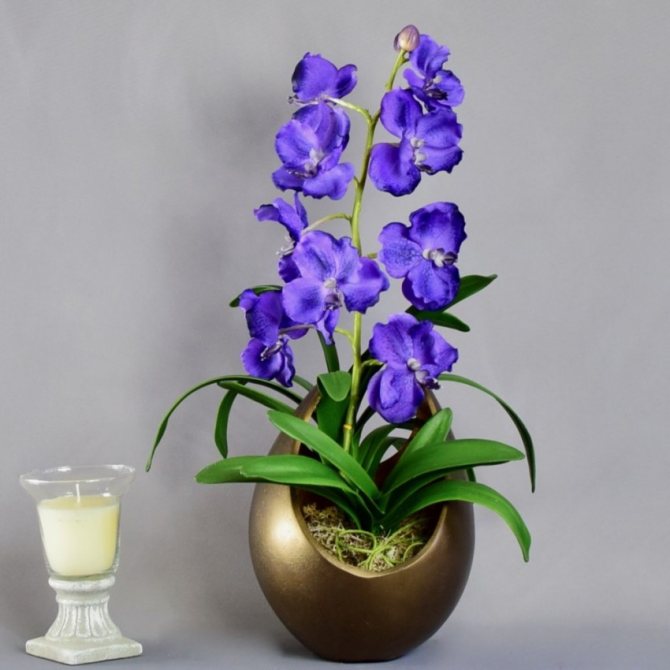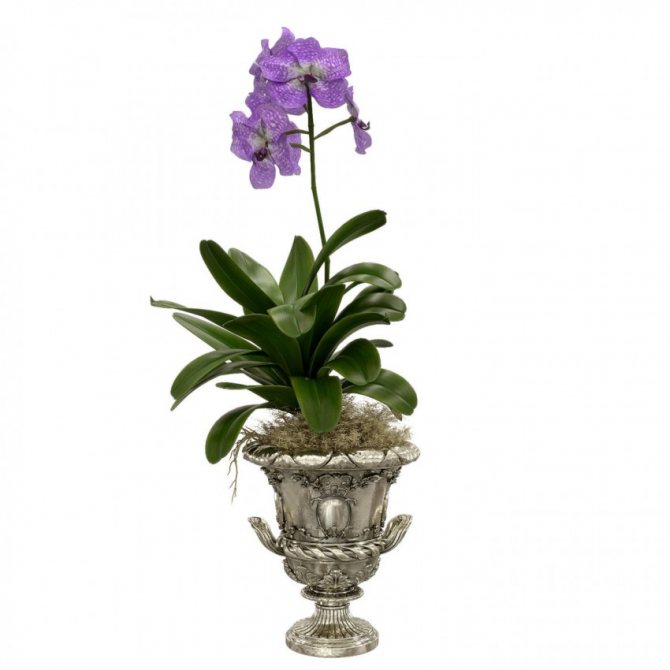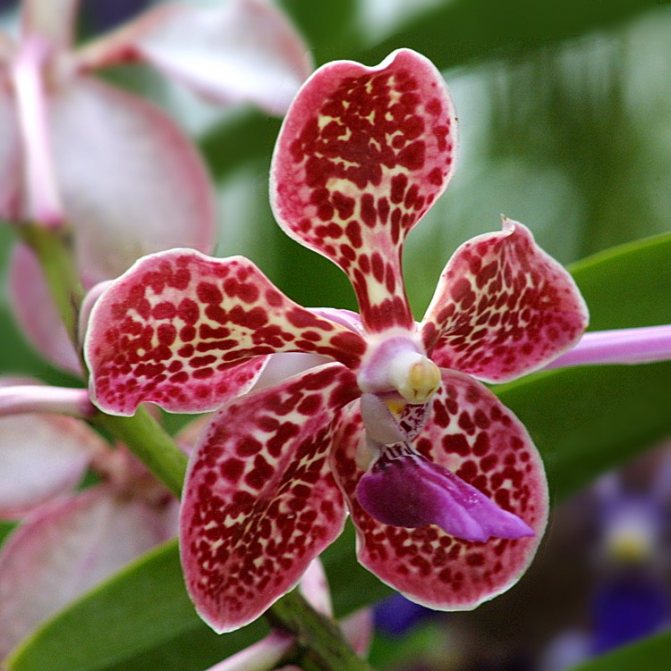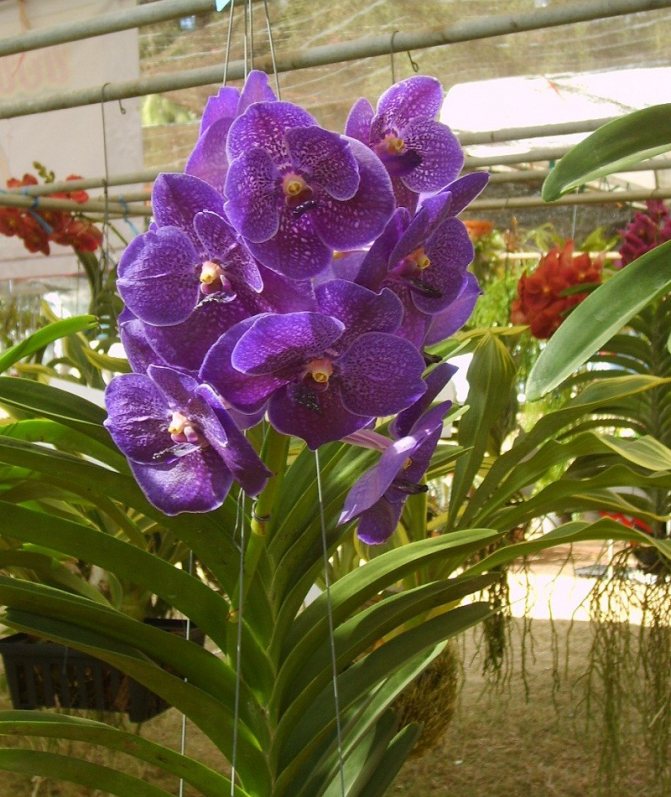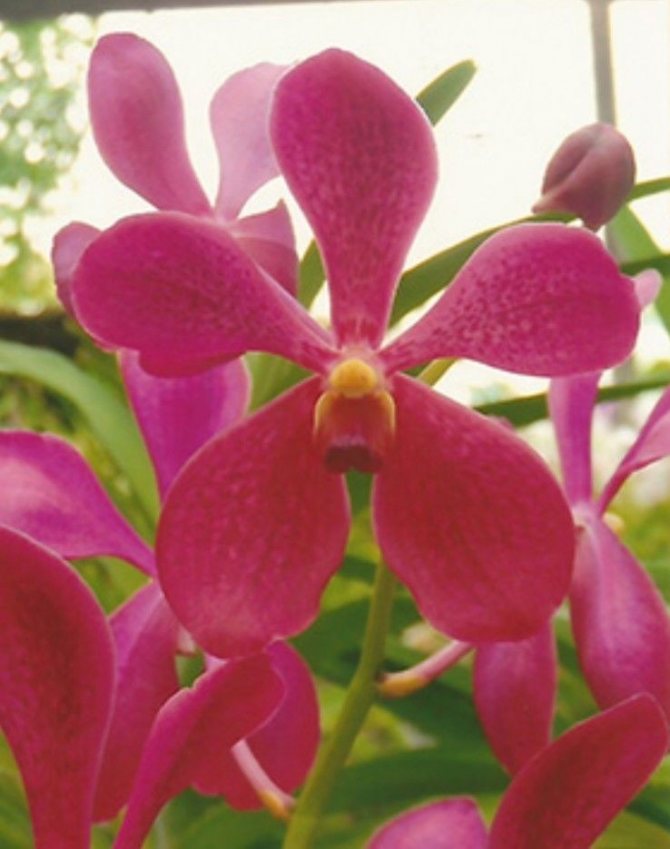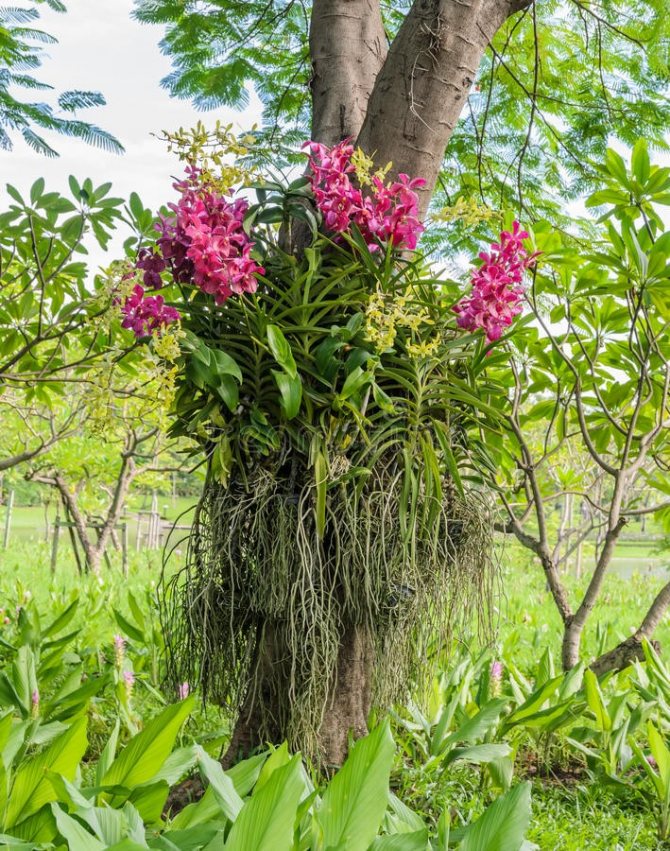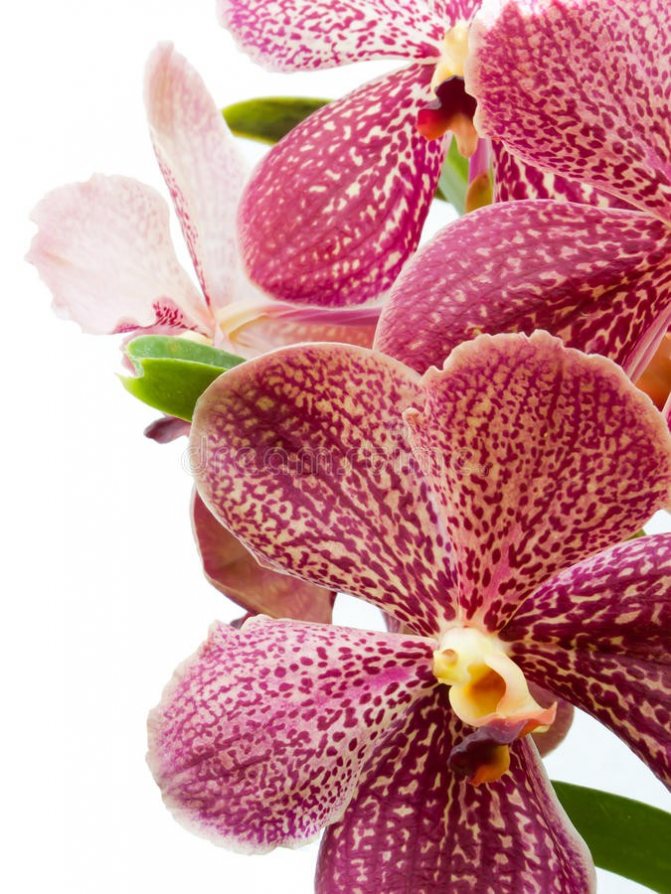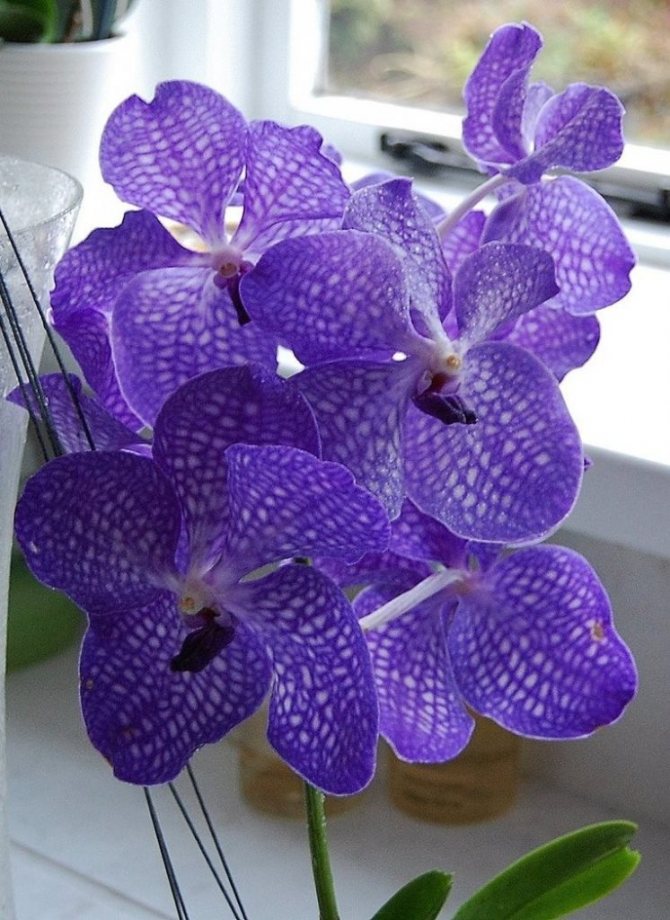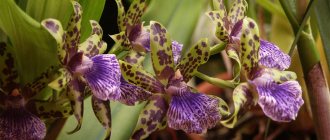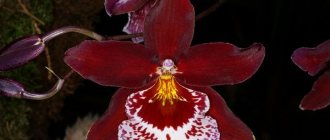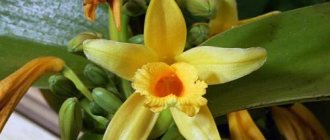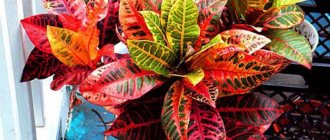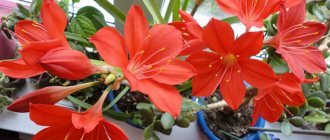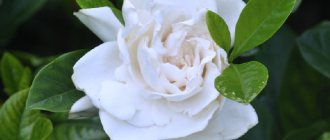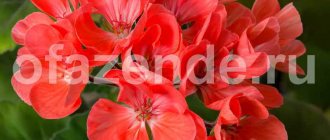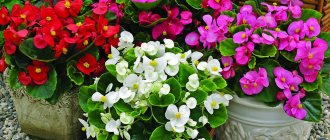Wanda is one of the largest and most beautiful orchids... They are quite demanding in terms of care and cultivation conditions. The plant responds to proper and good care with lush flowering almost at any time of the year.
These orchids are easy to cross, resulting in numerous hybrids adapted to the conditions of home cultivation.
Description of the plant
The Vanda Orchid is found in the wild in India, China and Thailand. Its large flowers, up to 10 cm in diameter, can be painted in a variety of colors. So, on sale you can find various shades of blue, red-violet and pink tones. There are dark mosaic markings all over the petals, giving this orchid a very attractive appearance.
This plant was named so in 1795 by the Englishman William Jones, who first described the flower while traveling in India. The genus Vanda successfully crosses with the closely related Ascocentrum, which has a more compact size. Thanks to breeding work, today you can find a wide variety of interspecific hybrids. Recently, the efforts of flower growers have been aimed at breeding miniature orchids.
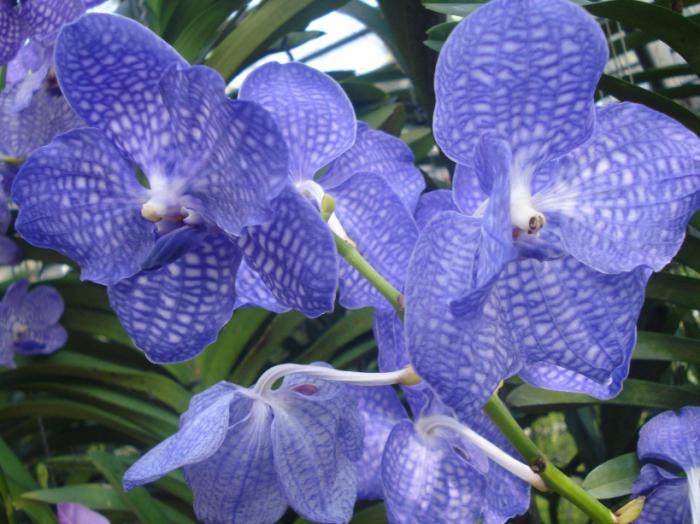
Homeland
The main habitats of the flower are located in the tropical regions of China, India, the Philippines, Australia and Indonesia.
The orchid was discovered by William Jones, who named her, as many think, in honor of the Polish princess Wanda. However, in reality, the scientist simply took the appropriate word from Sanskrit.
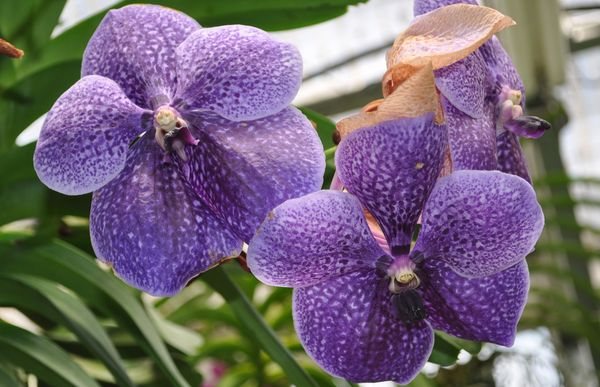

Varieties of Wanda orchid
There are many varieties of the Wanda orchid:
- blue;
- Sanderian;
- comb;
- Rothschild;
- rolling;
- chess;
- Hooker;
- tricolor.
Not every Wanda orchid is suitable for growing. At home, only 2 species are most often grown: blue and Sandler. These species are the basis for almost all hybrids of this genus. With their help, a huge number of different copies were created. These epiphytes have been used to breed the best orchid varieties used for cutting.
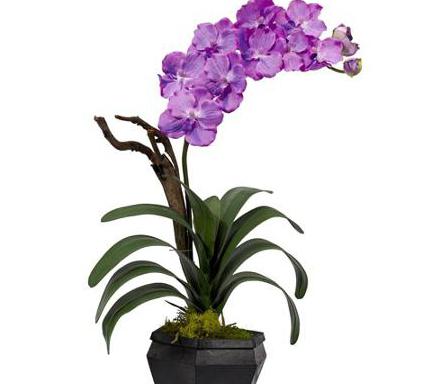

The main features of flowering
Various species or varieties, united in the genus Wanda, are characterized by flowering characteristics.
Season
These plants are characterized by lack of a natural resting period... With proper care, they respond with abundant flowering at any time of the year.
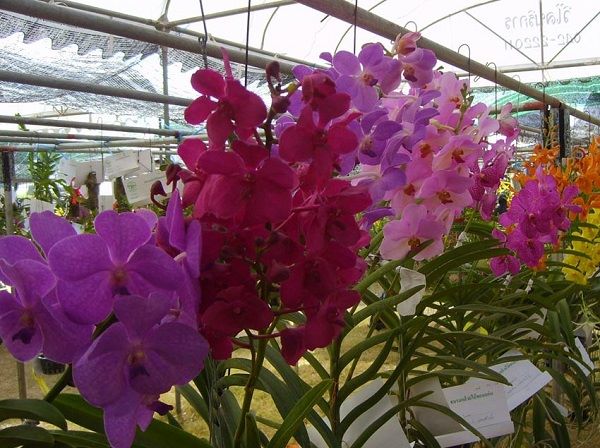

Wanda can bloom at any time of the year.
Duration at home
Depending on the lighting conditions Wanda blooms 1 to 3-4 times a year... The duration of flowering depends on the temperature of cultivation and is from 2 weeks to 1, 5 months.
Start
If you raised Wanda's baby with your own hands, then with proper care and favorable maintenance, it will bloom in 4-6 years.
Is it possible to repeat?
After the orchid faded, but the peduncle remained alive and green, re-flowering possible... Therefore, do not rush to cut the peduncle. Re-flowering may occur even three months after the flowers have fallen off.
The meaning of aerial roots
Above the roots are covered with a thick layer of porous dead cells - velamen, which the provides several functions:
- absorbs and retains moisture from the atmosphere;
- protects the plant from drought and harmful sun rays.
Unlike many other types of orchids, there are no pseudobulbs with a moisture reserve on the roots of Wanda, therefore, when kept indoors, they are more sensitive to air humidity and watering conditions.
Wanda blue
Vanda coerulea Lindl. - blue Wanda orchid. It has been grown at home for many years. It was discovered only in 1837 in tropical forests at an altitude of about 1000 m above sea level. This epiphyte has a strong, erect stem, the length of which reaches 80-100 cm. It is often very bare at the base. The stem is surrounded by tough, dark green leaves. Their length reaches 12-18 cm, and their width is 3 cm. The leaves are arranged in 2 opposite rows.
The Vanda orchid has lateral inflorescences. Their length reaches 30-60 cm. On each of them there are up to 14-20 large flowers, the diameter of which reaches 10 cm. Their lavender-blue color can have lighter or darker tones. This orchid blooms in the autumn-winter period. Most often, the first buds bloom in August. Vanda blue can bloom until December-January.
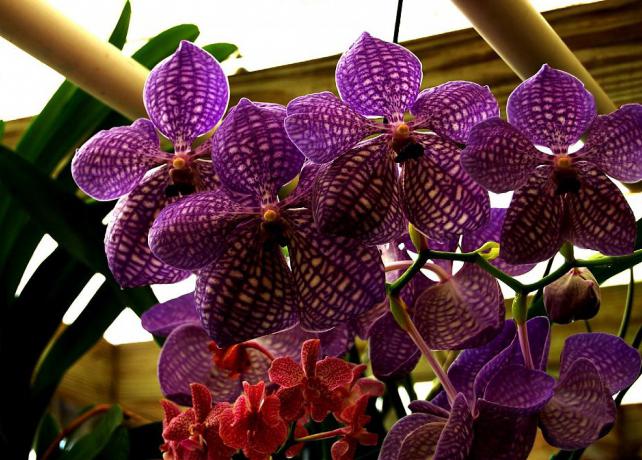

Reproduction methods
Cymbidium orchid: options for growing and care at home
Breeding the Wanda orchid involves two main methods, however, at home, flower growers prefer to use the most affordable and effective - lateral processes (or children).
By dividing
If aerial roots form on the upper part of the Wanda orchid, then it is carefully cut off, planted in a container with special soil for these flowers and placed in a warm, humid place (you can build a greenhouse), avoiding direct sunlight. The work is carried out with a pre-disinfected tool, the cut site is treated with crushed activated carbon.
The young plant is not watered, only spraying is carried out until it takes root well and starts growing. After that, you can take care of him according to the standard method.
Side shoots
An orchid of an unusual variety of Wanda and Cattleya, even with perfect care, extremely rarely forms side shoots, called babies. Even if such a miracle happens, then there is no need to rush to separate the young plant from the mother. The sprout must reach a height of at least 5 cm and form its own root.
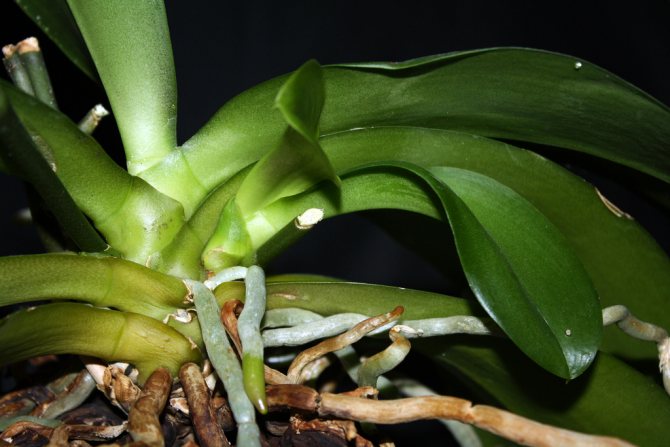

Reproduction of the Vanda orchid by side shoots
Only after that, the baby can be cut off from the main stem, planted in a pot with soil mixture for growing orchids and placed in a greenhouse, where the air humidity is maintained at 85%.
After 2 weeks, the young plant begins to slowly accustom to the climate of the apartment. When it reaches a height of 20 cm, it is transplanted into a larger container. It is imperative to treat all cuts with ground cinnamon or charcoal.
Growing Phalaenopsis Wanda indoors is very difficult, the process is troublesome and requires careful and careful care. However, the efforts of flower growers will certainly be justified after the beloved flower will delight not only with luxurious buds, but also fill the room with a fabulous aroma. In addition, it looks very unusual and exotic, therefore it is quite suitable for those florists who are bored with ordinary classics.
Wanda's disease
This orchid is susceptible to diseases such as:
- Spotting, which can be caused by excessive moisture in the substrate or in the air. In diseased plants, wart-like spots form on the underside of the leaf. It is often caused by fungal diseases that actively develop in warm and humid rooms. At the same time, rounded black spots appear on the upper side of the leaves. Orchids fight spotting by creating a favorable environment for the flower. When planting plants, the substrate is disinfected.Wanda is poured with water in which special antifungal drugs such as "Trichodermin" or "Fitosporin" are dissolved.
- Rot caused by waterlogging of the substrate. Most often, the disease progresses on cool days or when using containers unsuitable for an orchid. With this disease, rotting of the roots and stems is observed. Flower tissues soften and turn black. Very quickly, the plant turns yellow and dies. To combat this disease, the substrate is disinfected before planting the orchid. The plant is watered in accordance with the requirements of agricultural technology. The drug "Maxim" is added to the water.
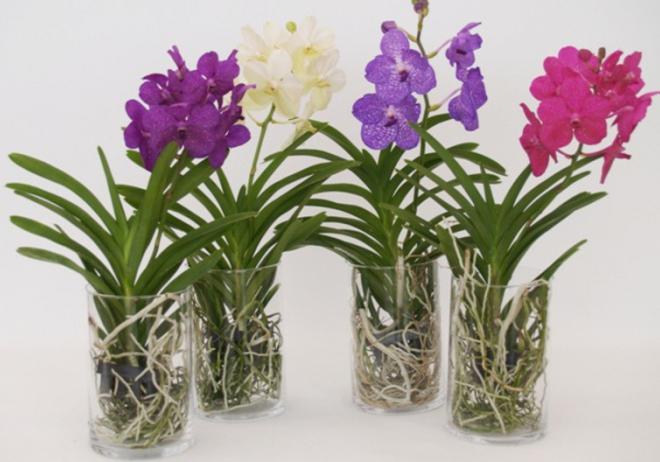

Possible problems
When caring for a Wanda orchid, various problems may arise, usually associated with some deviation from the rules:
- Rotting roots provokes excess moisture. To correct the situation, the plant must be pulled out of the pot, the damaged parts of the root system must be removed, the healthy roots must be treated with a solution of "Zircon" and the soil must be replaced.
- Falling buds due to insufficient humidity. They arrange a warm shower for the flower and do not forget to spray it regularly.
- Yellowing of leaves - a consequence of insufficient watering. You can prevent the problem by regularly submerging the plant in water.
- Brown spots on the leaves - traces of sunburn. The orchid needs to be removed to a shaded place.
- From a poor lighting Wanda's leaves and peduncle droop. The plant needs an additional light source.


Wanda's orchid pests
These wonderful flowers can infect such pests:
- Thrips, which are indicated by light spots or streaks appearing on the top of the leaves. Over time, parts of the plant acquire a whitish shade with a silvery sheen. Affected leaves turn brown and die off. Thrips also affect flowers. They become deformed and stained. To combat these pests, the drugs "Aktara", "Confidor" are used.
- Scabbards sucking out cell juice. On parts of the plant, immobile brown insects are visible. Affected orchid loses color, dries up and dies off. Pests are removed by washing the leaves and stems with a soapy sponge. The preparations "Confidor" and "Aktara" are very effective in the fight against scabies.
How to transplant Wanda?
Vanda orchid variety: photo
Before making a direct transplant, you need to make sure that the roots of the plant do not rot and that they are not damaged. If there are still rotting parts, it is necessary to remove them as soon as possible. The main thing is to do this while the Wanda orchid species is dry. It is systematically necessary to transplant young plants, because they are constantly growing, however, those whose roots are already too long will take quite a long time to adapt to life in new conditions, so they need an eye and an eye.
An urgent transplant to the Wanda orchid is required if any of this list takes place:
1) Too compacted substrate. Over time, they all become compacted after a sufficiently large number of waterings. This is fraught with the fact that the soil will cease to allow air to pass through and the plant will wither.
2) The substrate was initially of rather poor quality. This can be seen by how well it allows moisture to pass through. If the substrate does its job well and dries out quickly enough, then no transplants are needed. Otherwise, it, like the preparation of a more suitable substrate, is simply necessary.
3) Soil contamination. This also happens over time, no matter how good your substrate is. However, pollution can still be slowed down if the plant is handled very carefully.
4) The root system goes too deep into the ground. It also has the risk of the plant not getting enough moisture and nutrients, which of course we don't want.
5) The appearance of rot on the roots.There are many reasons for its appearance, but we will not focus our attention on them now. The main thing is that when you see decay, whatever its cause, you urgently need to remove the affected areas of the rhizome and transplant.
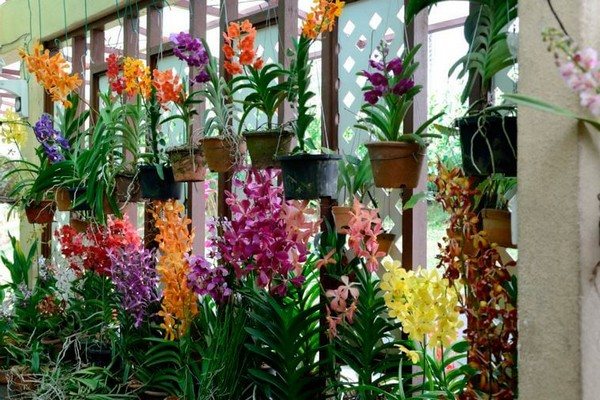

Vanda orchid variety: photo
Wanda's detention conditions
The Vanda orchid, which is somewhat easier to care for than other types of epiphytes, requires a relatively cool place for keeping. The optimum temperature for it in winter is 16 ° C. In warmer conditions, subject to all the rules of agricultural technology, it blooms and develops beautifully. Summer temperatures should not exceed 25 ° C. In winter, this epiphyte prefers dry keeping.
The Wanda orchid, the care and cultivation of which requires compliance with certain rules, is very demanding on lighting. With a great need for light, this epiphyte quickly burns out when exposed to direct sunlight. Light penetration from the street is permissible only in the morning and evening hours. Most often, in the autumn-spring period, the orchid needs additional artificial lighting. Fluorescent lamps are suitable for him. In such conditions, Wandas develop and bloom better.
The optimum humidity for growing Wanda is about 70%. Unlike other types of epiphytes, this orchid is not grown in trays of water, but in special hanging baskets. To maintain the required humidity, the aerial roots are regularly sprayed with soft water. Moreover, it is not only filtered or defended, but also boiled.
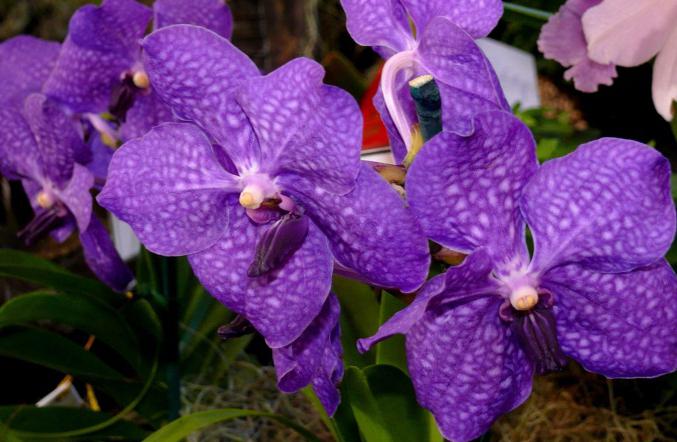

External characteristics
Vandas can vary greatly in their size and flower shape. Currently, breeding is aimed at obtaining plants of miniature sizes.
Height of an adult plant
Vandas are large plants, stem height which in home cultivation is about a meter, and for larger representatives - up to 2 m.
Number of leaves
Unlike many other members of the Orchid family, the number of leaves on the stem can reach several dozen, which is determined by the length of the stem. In this case, the lower leaves grow old and dry out, and new ones grow at the top.
Maximum peduncle length
One plant can release at the same time from one to four flowering arrows, on which from 2 to 15 flowers bloom... Depending on the variety, the size of the peduncle ranges from 30 to 50 cm.
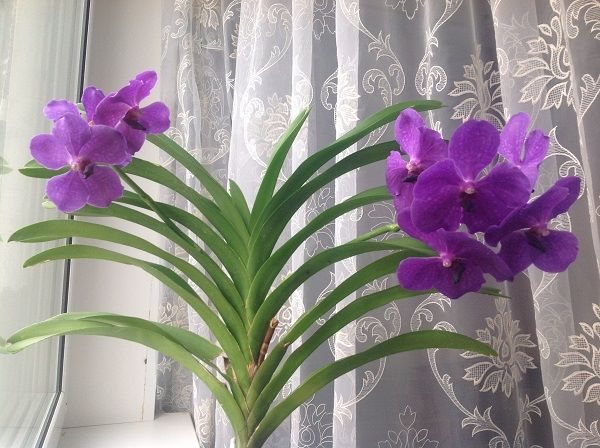

Wanda can produce several peduncles at once.
Diameter, flower shape
The size and shape of flowers in different species and varieties is very different: flower diameter ranges from 4 to 10 cm, for some representatives - up to 15 cm.
Most species have broad-leaved petals and regular flower shape with a characteristic lip for orchids... The few exceptions include species such as Vanda tricolor and Vanda cristatac with narrow teardrop lobes.
Watering and feeding Wanda
Wanda orchid, the care of which requires proper watering, is very sensitive to the water regime. During active growth in the spring-summer period, the substrate on which the epiphyte grows must be constantly moist. In winter, moderate watering is required. In this case, the plant needs water only when the substrate dries up completely. In the hot season, orchids must be sprayed with soft water. Do not allow moisture to enter the leaf axils after watering, as this can lead to damage to the plant by fungal diseases.
The Vanda orichid needs special fertilizing. They are produced during the period of active growth, budding and flowering. Fertilizers are mixed in the required quantities into the water for irrigation. As a rule, in the spring-autumn period, feeding is carried out weekly. Lack of nutrients in the substrate leads to poor flowering.
You should not be zealous with fertilizing the soil, since flowers that have received too much fertilizing become weak and elongated. Their top acquires increased softness and can bend under the weight of the inflorescence. You cannot fertilize diseased orchid specimens, as this can only aggravate the situation.
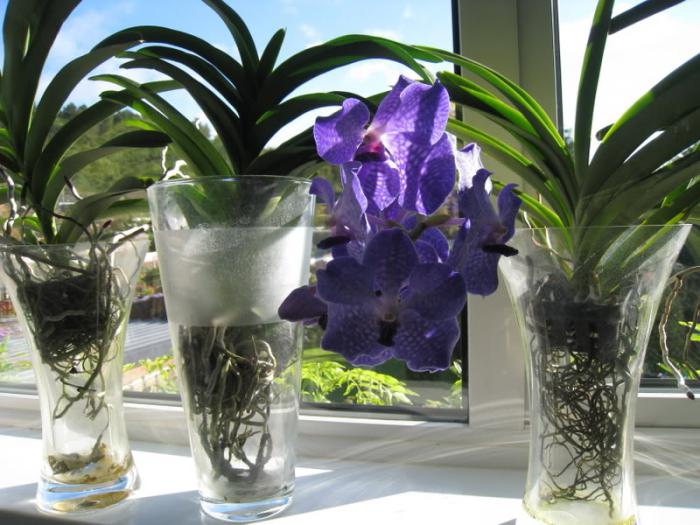

The specifics of growing and care
When settling the Wanda orchid at home, you should be prepared for the fact that caring for and growing it will require additional effort. This is not the case when room culture can be left out for weeks.
An abundance of light
This is how the first and most important requirement can be characterized, without which the most careful care will lose its meaning. This orchid is considered the standard of photophilousness. Not receiving the prescribed 10-12 hours of intense lighting, it stops growth, boycotts flowering.
The ideal option for room maintenance is a glazed balcony, a loggia, a bay window with a light source from several directions. The southern window will completely satisfy the plant from October to March, in spring and summer at noon hours the glass is shaded, if possible, the flower is transferred to a window with an east or west exposure.
Advice! Symptoms that say that your pet does not have enough light are dark green leaves, and the top pair is shorter than the penultimate one; stopping root growth, tightening the tip with a white velamen cloth. If this happens, the plant will be backlit or repositioned.
Thermal conditions
The most favorable temperature regime is considered, in which the flower actively increases its biomass. For the described group, this is the range of 22–28⁰ heat with a nighttime decrease of 6–8 degrees. In summer, it is useful to take Wanda to the open air, a terrace, an open balcony or a loggia, especially at night. During this time, the plant stores carbon dioxide, which is necessary for photosynthesis. Without daily fluctuations in temperature, especially if it is hot and dry, the plant will not grow fully.
Humidification and ventilation
The higher the humidity, the easier it is to care for the bare root system. A favorable interval for culture is 50–70%, but it makes sense under the condition of free respiration of the roots. Wanda does not tolerate stagnant air, its circulation is as important as lighting and humidification.
Video: the main secret of successfully growing wanda orchids.
Growing methods
Plant care is predetermined by the way it is grown. At home, several options are acceptable.
- In a hanging system with free hanging roots. This natural way of plant life is suitable for growing in a greenhouse, orchidarium, on a balcony. Prerequisites are bright light, humidity, ventilation. One of the inconveniences of this method of maintenance for an apartment is the frequent spraying of the area of leaves, roots, which means moisture gets on the floor, furniture.
- Growing in glass vases. It is beautiful in the photo, the plant is easier to care for. The essence of the method - the root system is placed in a volumetric glass vessel (vase, aquarium, jar), the leaf part is left outside. At the bottom of the vessel, you can put expanded clay, large pieces of bark. After watering, they will evaporate moisture, regulate the microclimate in the root zone.
- In decorative baskets or pots. The flower, together with the hanging box, is placed in a basket with many holes through which air can freely penetrate.
Advice! When choosing a vase, give preference to the shape of the glass - a wide vessel with a narrower neck - this will make the plant easier to fix. The size should correspond to the volume of the roots with a margin for their growth.
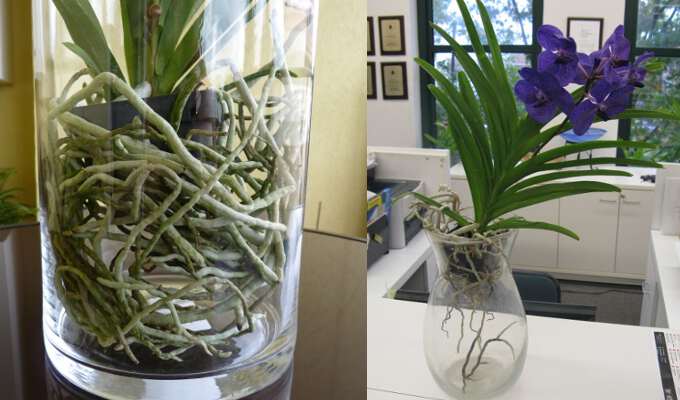

Watering features
Watering frequency directly depends on temperature, lighting, orchid growing method. In spring and summer, plants in the suspension system are watered every day or every other day. The best way is a warm shower. Once every 7-10 days, the roots are soaked for 30-40 minutes.
A slightly different care for Vandas in vessels - the container is poured with water, left for 1-2 hours.While the roots are drinking, air bubbles rise from the bottom, then the water is drained.
An obligatory care procedure is daily spraying of the root and leaf area.
In winter, watering is reduced to 1-2 times a week, only the roots are sprayed.
Advice! The optimal time for watering is in the morning, because moisture is important for photosynthesis under the influence of the sun. You can not spray the flower and leave it wet overnight - this is fraught with rotting of the leaves, root collar.
Top dressing
Wanda loves to eat, caring for her includes mandatory feeding. Targeted fertilizers for orchids in a low concentration (20-25% of the norm) are added for every second watering, with active growth of roots, leaves, peduncles - for every watering. During flowering, top dressing is not carried out.
Bloom
When the plant kicks out the arrow, grows buds, blooms, it is especially sensitive to watering. With a lack of moisture, it can dry out the peduncle, discard unblown buds. After flowering, it rests for 30–40 days (at this time it must be kept drier), then it begins to grow roots and leaves.
Reproduction and transplantation of Wanda
These orchids reproduce by separating part of a healthy stem, which has aerial roots. Apical cuttings or side shoots are also used. Adult orchids are transplanted only when their roots do not fit in the pot or Wanda slows down growth. As a rule, this epiphyte needs to be transplanted every 3-4 years. At the same time, the container for the flower is not chosen too large, since in such a container it slows down growth.
They buy a special substrate for orchids for Wanda. In extreme cases, you can prepare the soil mixture yourself. To do this, take 2 parts of pine bark, broken into large pieces, 1 part of perlite / foam chips, ½ part of peat. Pieces of birch charcoal are added to the mixture.
Wanda does not need to trim plant parts. In the event that the orchid becomes very tall (long), you can cut off its upper part and plant it in the substrate. Such planting material should have at least 3-4 healthy roots. Tissue sections are sprinkled with crushed charcoal. The lower part of Wanda eventually gives birth to a “baby” based on the epiphyte. For reproduction, daughter plants formed in the axils of the leaves are also used. They are simply carefully separated and deposited in a separate container.
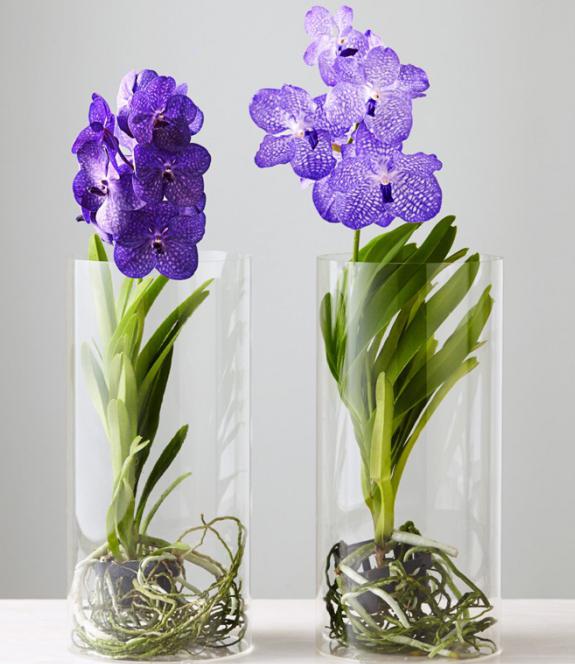

Testimonials
Michael. “My yellow Wanda has been growing for five years, the first few years it did not bloom, it is obvious that I didn’t like it. Now I have found the optimal care, and she bloomed with large flowers. This is an extraordinary, very showy plant. "
Alla. “I have been in love with Wanda for a long time. I already have six of them at home. I tried to grow them in different ways: in pots, in vases and pots. But 5 years have passed and now they are hanging on the window without any substrate. There are no problems, the air humidity in the apartment suits the roots. "
Olga. “I have many favorite colors, but Wanda is the most coveted in my collection. It blooms with unusually beautiful flowers, loves a lot of sun and daily care. But it's worth seeing such beauty every day. "
Oksana. “I first saw Wanda at the neighbors. The plant impressed me so much that I also decided to purchase. Now it grows in my basket, with bare roots. Feels great and makes me very happy. "
The choice of packaging for the Wanda orchid
Not any container is suitable for growing Wanda orchids. Most often, hanging baskets or pots with side holes are chosen for her, into which the roots of the plant penetrate. In them, the epiphyte feels as comfortable as possible. Recently, the Vanda orchid in a vase is often on sale. Moreover, there is no substrate in such a container.
The Wanda Orchid in glass is a great gift idea. For her, you can choose a glass container of any shape. This epiphyte looks perfect in tall and spherical vases, flasks and "glasses". Unfortunately, orchids that are sold in glass containers with a sealed lid die very quickly.
Types and varieties of varieties
Most of the orchids that are sold in stores are represented by interspecific and interspecific hybrids, which are quite well adapted to cultivation in an apartment.
Tricolor
This orchid has an erect stem up to 1 m long, covered with belt-like leaves 26 to 40 cm long.
The flowering arrow carries 7-10 flowers, reaching 7 cm in diameter... The petals are teardrop-shaped, with a speckled reddish-brown pattern, main color is white or light cream.
Bloom: October - January, May, June.
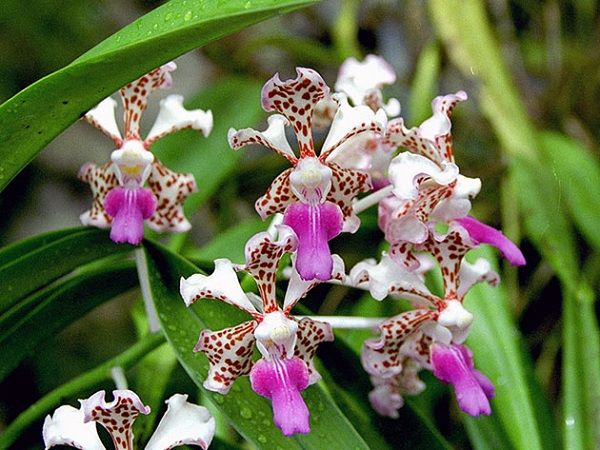

Tricolor.
Rolling
Has a highly branched drooping stem up to 2.6 m long and folded leaves about 20 cm long. The flowering arrow bears 3-6 flowers of a delicate pink shade about 10 cm in size.
The petals are diamond-shaped or oval-shaped, the edge is wavy. The middle lobe of the lip is separate, saturated purple, the lateral lobes are light, at the base they acquire a rich yellow color.
Bloom: October.
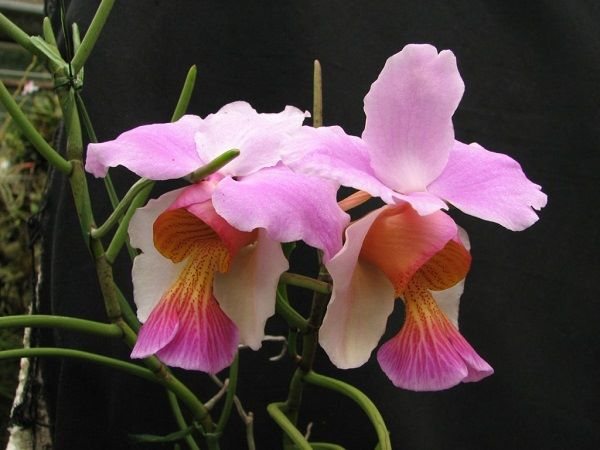

Rolled.
Rothschild
A hybrid obtained by breeding the parental species Vanda blue and Sandera. From them he received an unusual colors in all shades of blue and light blue, mesh pattern of petals and resistance to cold (withstands up to + 10C), flowers about 4-6 cm in diameter.
The flowering period is 4 to 6 weeks. Due to its unpretentious care, the plant is very popular among flower growers.
Bloom: October - January, May, June.
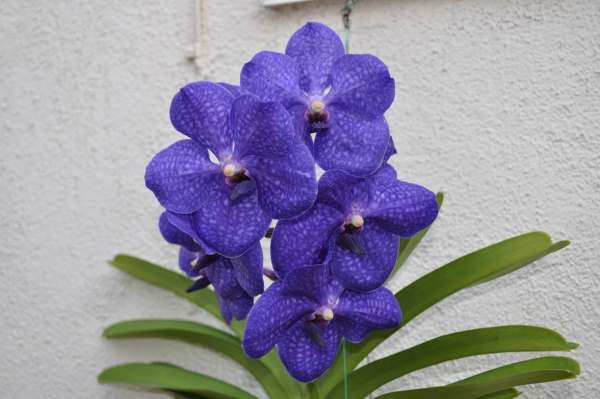

Rothschild.
Blue
The most spectacular type, which is widespread among florists. The stem is erect, up to 1 m high, the leaves are dense, with a serrated edge, up to 25 cm long.
The flowering arrow grows up to 0.5 m, inflorescences bear 6-15 flowers with a diameter of about 10 cm... The petals are light blue, the lip is of a darker shade, sometimes with a mesh pattern.
Bloom: from early September to October.
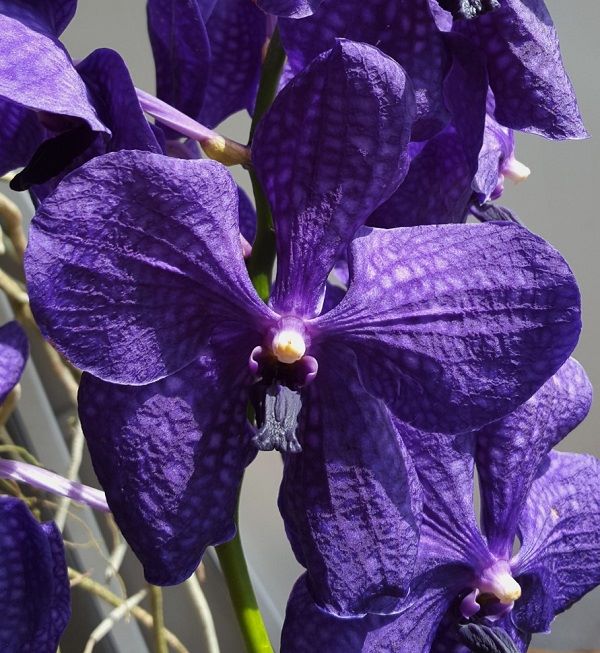

Blue.
Growing Wanda in a glass vase
The Vanda Orchid in a vase, the care of which consists in regular inspection of the flower and removal of damaged parts, looks very stylish as an element of the interior. A container with a wide base is best suited for such an epiphyte cultivation. An orchid that is constantly in the water can quickly rot and die. Therefore, it is better to keep it dry. The flower is regularly removed from the vase and immersed in water with fertilizers for a while. Then the plant is slightly dried and returned to the container. Orchids live the longest, the green parts of which are outside the glass container.
Care
Wands are quite capricious in growing orchids, requiring daily care:
- regular watering;
- high air humidity;
- intense lighting;
- and most importantly - good aeration of the root system.
Without these conditions, the plant will get sick, which will primarily affect the state of its leaves and flowering.
Helpful advice! In summer, it is worth taking Wanda out into the garden, hanging it on a balcony or tree. Such airing will do her good, and she will thank you with lush flowering.
Pests, Wanda Diseases and Methods of Controlling Them
| Manifestation | Cause | Elimination method |
| The leaves have round black markings along their entire length. | Fungal infection. | Treat infected areas with fungicide. Reduce the frequency of watering to 1 time per week, maintain a constant temperature of + 23 ... + 25 ° С. Cover with cloth, avoid bright light. |
| The horse system rots, becomes covered with a black coating and dies. The stem with leaves dries up. | Bacterial rot. | Remove the infected areas, cover the cut sites with phytosporin. Replace the soil and disinfect the container. Antibiotics (tetracycline) are also effective in the proportion of 1 gram per liter. |
| Black dots protrude on the outside of the leaf, the stem may be covered with brown lines. | Viral infection. | It is impossible to completely cure.Dispose of the infected plant to prevent spreading the infection. |
| Small green insects appear throughout the orchid. The stems and leaves wither, the plant dies. | Aphid. | Increase the humidity of the air, treat the flower with soapy water or lemon peel tincture. Special intestinal preparations (Intavir, Aktofit) are best suited to combat the pest. |
| Small beige pests on leaves, peduncles, buds and stems. White bloom and waxy deposits. Wanda fades. | Mealybug. | Remove growths, affected parts of the plant. Treat the bulb with an alcohol solution, remove parasites. Aktara, Mospilan, Aktellik, Calypso are great for wrestling. |
| Small voids appear on the leaves and stem. Yellow spots appear, shoots die off. | Shield. | A solution of soap and alcohol, fern tincture and chemicals such as Permethrin, Bi 58, Phosphamide, Methylmercaptophos will help get rid of the pest. |
Location and lighting
Wandas are very light-loving orchids. She needs about 55,000 Lux. Only southern windows can provide such sun during the year. But in the spring and summer, our aggressive sun gives out up to 70,000 Lux, and this already threatens with serious burns, up to the death of the orchid. Therefore, during this period, Wanda on the southern windows must be shaded.
You can determine when the plant has a lot of light by the freckles that appear on the leaves.
Softer in relation to the sun - southeast, west and southwest windows. But in winter, the power of light for a vanda orchid there may not be enough, so you need to watch the tips of the roots: if they grow, then there is enough light.
If there are only northern, north-western or eastern windows in the room, then Wanda will grow very slowly there, and it will never bloom. You can get out of the situation due to powerful additional lighting.
When Wanda is kept in an apartment, no matter what window she grows on, in the winter period it must be supplemented so that the daylight hours are at least 12 hours.
How to care
Watering nuances
An orchid requires alternating wet and dry cycles for excellent flowering. On hot summer days, it needs to be watered daily, and in autumn and winter, the number of waterings should be reduced to one in one or two days.
Please note that moisture should not stagnate at the roots, so after it drains, pour excess water from the pan.
An orchid can be watered in several ways. Among them:
- warm shower;
- immersion;
- watering the substrate with a watering can;
- spraying.
A warm shower can be arranged for the orchid weekly in the summer.... To do this, put the plant in a bath and pour warm water. Leave it for an hour to let all the water drain, then wipe the leaves with a soft cloth and drain off any excess water.
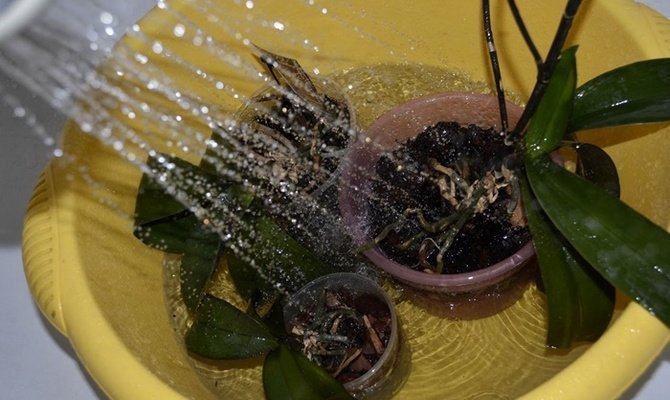

A warm shower is suitable for the plant as an additional watering option for the summer period.
Immersion irrigation method is very effective... To do this, pour water into a basin and place the pot with Wanda in it for about 20 minutes. During this time, the roots are saturated with moisture (their greening will be a signal of this), and the plant can be removed from the basin.
Watering with a watering can can be done daily on warm days. Moisten the substrate with warm, settled water, pouring it along the edge of the container.
Spraying is recommended several times a day during the hot season. Moisten only the orchid leaves in this way, being careful not to get the droplets on the aerial roots.
Top dressing
It is recommended to fertilize Wanda with preparations for orchids monthly when watering. To do this, dilute the fertilizer as indicated in the instructions and add it to the water. Pour the nutrient solution into a basin and place the orchid in it for about 30 minutes.
The specifics of growing in a vase or glass flask
On sale, Wanda can often be found in a glass vase, glass or flask. It is not only beautiful, but also very convenient. The watering procedure is greatly simplified, moreover, the plant develops in suitable humid conditions.
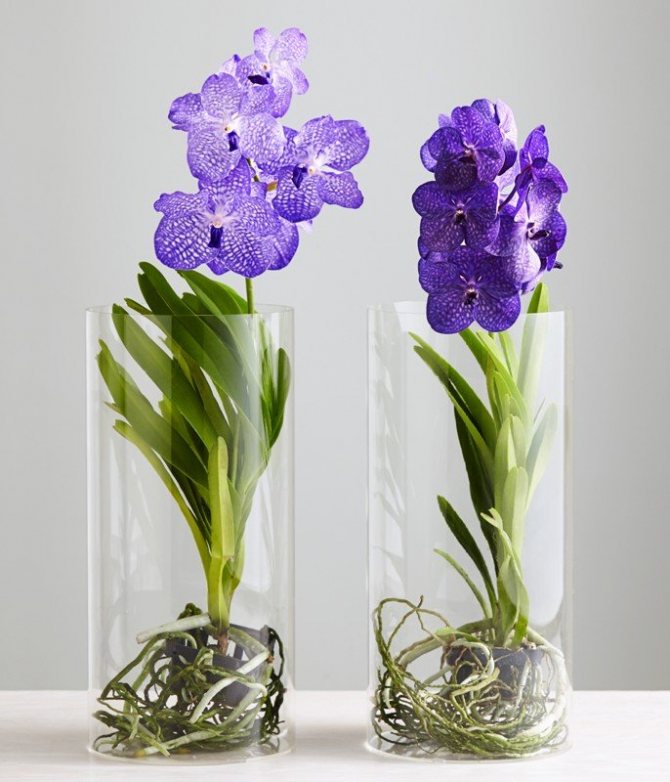

It is very convenient to grow Wanda in a vase.
If you purchased Wanda in a glass flask, then you need to remove the plant from the vase and install in such a way that the upper part of the flower rises above it, and the roots are located inside the flask... When watering, it is enough to pour warm settled water inside the container and leave it inside for 20-30 minutes. Then the excess moisture must be drained. Between the procedures, the roots should dry well, only after that the next watering can be carried out.
Please note: the roots should not come into contact with the water accumulating at the bottom of the vase or flask, otherwise they will rot.
Flowering secrets
Under favorable conditions and good care, Vanda blooms twice a year, without requiring additional stimulation.
If your orchid does not want to bloom in any way, then it is necessary to change the conditions of detention or organize a stressful situation for the plant.
An excellent stimulator of flowering is a rather large difference between day and night temperatures, it should be about ten degrees... It is rather difficult to achieve such a difference in room conditions, so in summer it is preferable to keep Wanda on the balcony, and in winter to move the pot closer to the window in the evening, and in the morning, on the contrary, move it away from it.
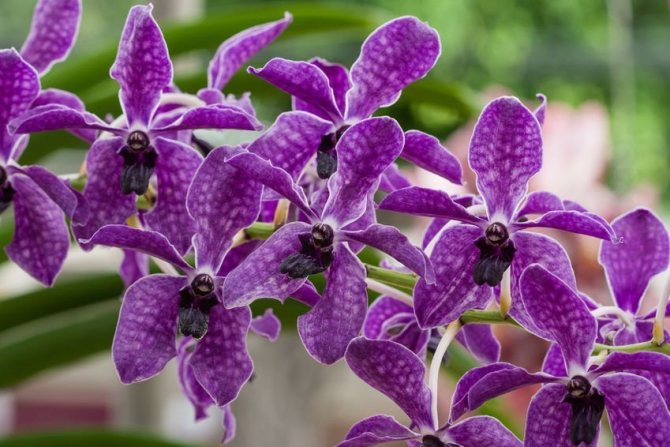

With good care, Wanda blooms twice a year
When the orchid faded and the peduncle began to dry out, it was time for pruning. Using a pruner, knife or scissors, cut it off, leaving a small stump about 1 cm at the base. Cover the cut with beeswax.
What to do during the rest period
Wanda does not have a pronounced rest period... However, after the end of flowering, she needs to arrange a rest - to reduce the number of watering and stop feeding. The temperature of the content should also be reduced to 16-18 degrees. All these activities are needed in order for the plant to gain strength before the next flowering.
How to make a vanda bloom long and profusely?
This orchid blooms in its homeland all year round, but in our conditions this is not to be expected from it, so it usually blooms in spring or summer, when the lighting becomes more intense. In order for a wanda to please with its beauty for 1.5-2 months, 2 conditions must be met: 1) regular feeding and 2) a special temperature regime.
With the first, everything is quite simple. Add half the dose of the orchil-specific fertilizer with every second watering, and when spraying, add a quarter of the concentration indicated on the package. Alternate root and foliar dressings.
The second condition is more difficult to comply with: it is necessary to ensure a daily temperature difference of 5-7 degrees. Those. if during the day in your room + 22-24 gr., then at night it is desirable + 17-19 gr. Moreover, such a regime is good to observe not only during flowering, but also during the dormant period, which occurs in late autumn. At this time, in the absence of artificial illumination, the plant stops growing - the upper leaves stop lengthening, and the tips of the roots are covered with a grayish skin - velomen and also stop growing. During the rest period, watering for the wanda is reduced, otherwise decay cannot be avoided.
Substrate composition
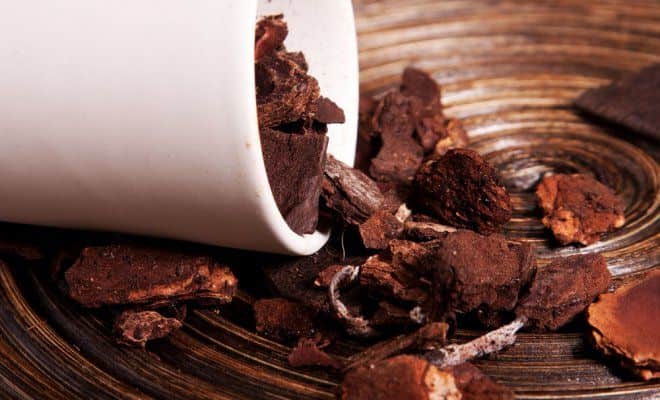

Soil for a flower
There is no need to replant the orchid immediately after purchase. You can simply place the container with the plant in a lattice container or basket filled with a light breathable mixture of moss, pine bark, coarse sand, perlite, charcoal, expanded clay. Peat and garden soil should not be added. The bottom of the basket can be covered with a layer of pebbles, and the side walls can be covered with air and water permeable material so that the substrate does not spill out. It is not recommended to use polyethylene.
Problem solving: how to save the dying Wanda
Sunburn and other consequences of improper care - table
| Problem | Possible reason | How to fix the situation |
| Roots rotted | Waterlogging |
|
| Buds fall off | Too little watering or pests |
|
| Leaf blades turn yellow | Lean watering |
|
| Brown spots on the leaves | Sunburn | Move the flower to a different place or shade it with tulle. |
| Wanda grows horizontally, droops | Not enough light | Move the flower to a different location. |
| Soft brown spots on the leaves | Fungal disease from waterlogging, including at low temperatures in the room |
|
| Wanda does not bloom | Any care mistake or lack of light |
|
A plant weakened by improper care becomes an easy prey for insects and pathogenic microbes.
Diseases and pests of orchids - table
| Diseases and pests | Signs | Reason for appearance | Treatment and prevention measures |
| Fusarium wilting |
|
|
|
| Chlorosis | Yellow streaks on the leaves | The plant lacks iron |
|
| Root rot |
| Waterlogging |
|
| Spider mite |
| Dry indoor air |
|
| Shield aphid (scale insect) |
| Insufficient humidity in the room | You can get rid of the scale insect using mechanical treatment: scrape off the tubercles and wash all parts of the plant with a cotton swab dipped in soapy water. |
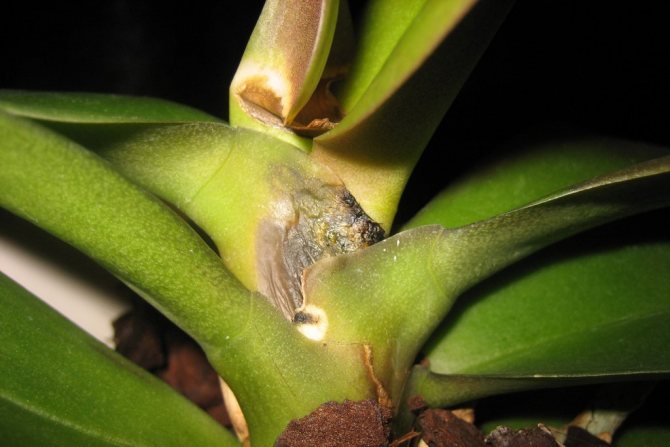

Fusarium is a dangerous fungal disease that Wanda orchid often suffers from
Resuscitation of a plant without roots
In the treatment of root rot, fusarium wilting, as well as from old age or due to improper care, Vanda is often left without roots. In this case, urgent resuscitation of the orchid is necessary. It is necessary to create conditions for it to grow new fleshy roots.
Hanging
The easiest way is to hang Wanda in a semi-shaded place:
- Remove the plant from the old substrate and cut off all damaged parts.
- Secure the remainder with wire and hang in a semi-shaded place with the top pointing down.
- Make a solution of special fertilizer for orchids in half the recommended concentration and add granulated sugar to it (all components of the nutrient mixture must be taken in equal parts).
- Spray the whole plant with the resulting solution daily.
- The duration of such resuscitation can vary from two to three months.
- After new roots grow up to 3–4 cm, turn the orchid over and plant it in a pot with a substrate.
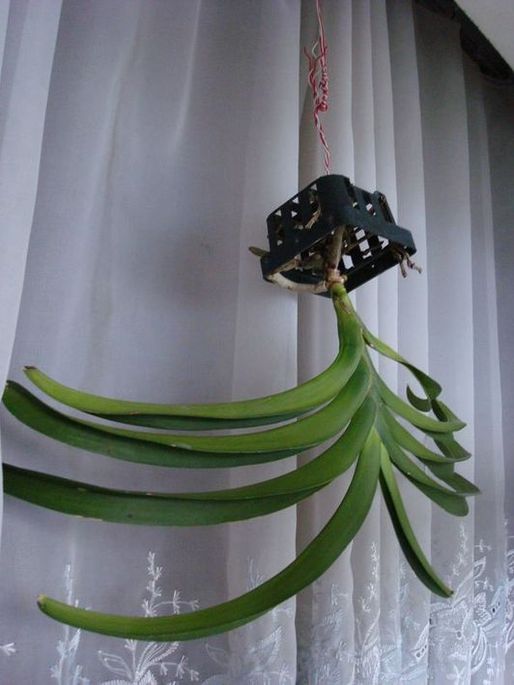

The easiest way to resuscitate an orchid is to hang it
Greenhouse application
If your apartment is not humid enough, then you can reanimate the orchid in an impromptu greenhouse. However, it is necessary to monitor the plant especially carefully in such conditions, since excessive moisture can destroy it.
Proceed like this:
- In a diseased orchid, cut off all the affected parts and dust the slices with ground cinnamon or brush with greenery.
- Treat the sections with Fitosporin and put a plastic bag on top.
- Hang the resulting greenhouse with the top of the orchid down.
- Remove the bag daily and ventilate the plant, spray the lower part of it with a rooting stimulant.
- In about a month, the roots should appear. Once they are 3–4 cm long, the orchid can be planted in a normal substrate and cared for like a healthy plant.
Location on the west window
In the summer, quite powerful lighting in the afternoon is typical for western windows. At first in autumn and until spring, the plants must be supplemented for 4-6 hours, since for good growth and full bloom, the Wanda orchid needs bright lighting for 12 hours a day. For this purpose, it is recommended to use energy-saving phytolamps. Similar devices should be used in the summer on cloudy rainy days, when the room is half-dark throughout the day.
How to properly grow an extraordinary indoor flower?
Community of green men
Vanda Wanda. Epiphytic or semi-epiphytic orchids with powerful aerial roots of gray-green color and narrow belt-like leaves located on an erect shoot in two opposite rows. The flowers are large, beautifully colored, fragrant, in loose axillary racemes on long peduncles. The flowering of the brush lasts up to 3 months. Vandas can bloom several times a year.
Etymology
The name of the genus resembles the well-known female name, but it has nothing to do with it. In the name of the genus, a Sanskrit word is used - the local name for the first described type of vanda, namely, chess vanda (Vanda tesselata). Later, all orchids belonging to this genus were called vandas.
Types and varieties of wanda orchids
The genus unites about 70 species of epiphytic plants common in the tropics of Asia, India, China and the Philippines.
In addition, there is a huge number of interspecific and interspecific hybrids in the culture, since Vandas easily interbreed both within the genus and with orchids of other genera.
This bright and exotic orchid is used to decorate warm flower gardens in greenhouses and conservatories.
Vanda blue (Vanda coerulea)
The specific name translates as "heavenly", meaning the color of the flowers. Homeland - the tropical forests of the Himalayas and Burma.
An epiphytic orchid with belt-like leathery leaves arranged in two rows and thick aerial roots. Inflorescences (12-20 large flowers) grow from leaf axils, up to 30-60 cm long. Flowers are large, pale blue, with dark veins, up to 10 cm in diameter. Bred brightly colored blue and pink forms with a dark mesh and a rounder and flatter flower.
A pot culture is preferred, however, under conditions of daily spraying and constant high humidity, the orchid can be kept with fully open roots, i.e. in a block culture.
Blue Vanda culture is demanding for coolness, as it comes from the mountainous regions of India.
The genus Vanda, as well as the close ones Euanthe, Ascocentnim, Rhynchostilis, Aerides and their hybrids are fairly common plants, originating from the regions of Southeast Asia to Papua New Guinea and Australia.Most of the flowering vandas are rather large plants, so the Ascocendians are more popular. These are, as a rule, more compact plants with round flowers of the correct shape of a wide variety of colors.
Blue Vanda (Vanda coerulescens)
Homeland - China, Burma, Thailand. The first copies of which were found in 1837 by the famous botanist Griffiths.
Miniature view, leaves are collected in a rosette. Blooms in late winter and spring. Multi-flowered inflorescence, consisting of long-lived fragrant flowers, 3 cm in diameter.
Vanda Suarez, or Vanda gentle (Vanda suaris)
Homeland - the island of Java.
The stem is 60–90 cm long, bears dark green belt-like leaves arranged in two rows. Flowering, which is usually abundant, begins in spring. The racemose inflorescence consists of 10-12 fragrant flowers 5-7 cm in diameter. The petals and sepals are wavy, white, with purple dots. The lip is three-lobed, bright pink.
The popular form var. tricolor is a large plant, up to a meter or more in height, leaves up to 25 cm long and 2-3 cm wide. Peduncle with 5-10 flowers, shorter than leaves. The flowers are fragrant, star-shaped, white-cream, with spots and stripes of a red-brown top, about 7 cm in diameter.
Vanda cristata (Vanda cristata)
The species is distinguished by large, up to 5 cm in diameter, fragrant flowers of yellow or blood-red color.
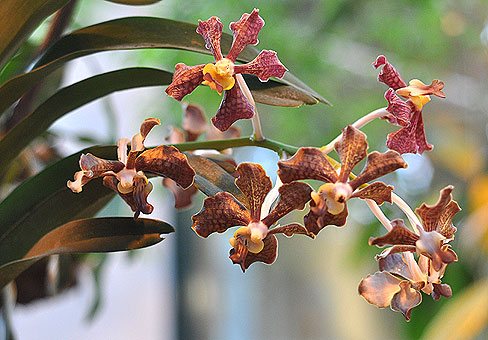

Vanda densoniana
Vanda the great (Vanda insignis)
Homeland - Malaysia.
A large evergreen plant with a thick stem and tough, elongated leaves. Blooms in summer. The peduncle is 18 cm long, has a racemose inflorescence consisting of several brownish-yellow long-lived flowers 4–5 cm in diameter. The lip is large, rounded, pink.
At the end of the XX century. many new hybrids have been obtained from this species in Thailand.
They also grow species such as
Vanda javierae is a rare and very showy vanda species recently found in the Philippines. About eight white flowers bloom on the peduncle, the lip is also white with pale pink and brown markings at the base.
Vanda sanderiana is one of the most adorable Vanda species native to the Philippines. Wanda is a warm-keeping epiphyte that is widely used to create new hybrids. Multi-flowered racemes consist of large, rounded flowers, painted pinkish or pale purple with dark veins and a pattern on the lateral sepals. There is an albino form known as Vanda sanderiana van albata with greenish-white flowers.
Hybrid wanda orchids
In the practice of floriculture, preference is given to hybrids with spectacular large flowers, the flowering period of which depends on the type and conditions of detention. This bright and exotic orchid is used to decorate warm flower gardens in greenhouses and conservatories.
Vanda fuchs
The variety became popular at the end of the 20th century. It was obtained by crossing the varieties 'Donna Rome Sanches' and 'Pat Delight' and officially registered in 1994. Since then, Fuchs has been widely used in the process of further hybridization. It and its derivatives are characterized by a peculiar spotting of the petals and lips of flowers. Background shades can range from blue-violet to pink-red.
Vanda gordon dillon
The variety is distinguished by a varied color of rounded flowers. Monopodial orchids with strong, white, fleshy roots. The leaves are elongated, light green, 15–20 cm long. The peduncle bears a racemose inflorescence 15–25 cm long.
The plant needs regular watering and feeding throughout the year, an abundance of light and moderately warm content.
Vanda kultana
A Vanda variety that blooms several times a year. The stem is straight, 45-60 cm high. The leaves are green, belt-like, arranged in two rows.
The flowers are large, fragrant, purple, with white streaks, collected in racemose inflorescences of 20-25 pieces. Flowering lasts for several months. Plants of this variety require warm and moist content.
Vanda roberts delight
Leaves are light green, hard, elongated.The peduncle bears a racemose inflorescence containing 15–25 fragrant bright pink flowers. These orchids are very light-requiring.
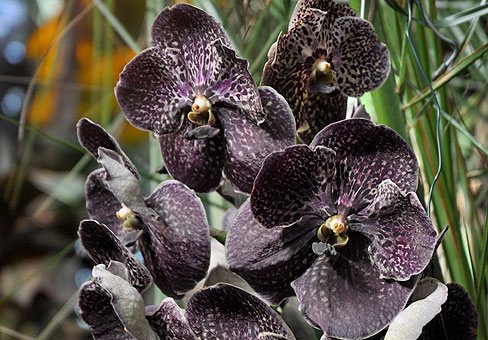

Vanda fuchs delight
Vanda rothschildiana
A hybrid obtained by crossing two species - Vanda sonderiana and Vanda coerulea.
Leaves are dark green, belt-like. Flowering begins at the end of September. Light blue flowers are collected in multi-flowered inflorescences. The diameter of individual flowers is 4–5 cm.
Plants are recommended to be kept in a wooden basket-box.
Vanda sansai blue
An unpretentious hybrid of an orchid with blue flowers. The multi-flowered inflorescence stays fresh and aromatic for 4-8 weeks. During flowering, the plant requires abundant moisture and intense artificial lighting.
Vanda reverend masao yamada
A brightly colored, beautifully shaped hybrid that inherits these characteristics from Vandasanderiana.
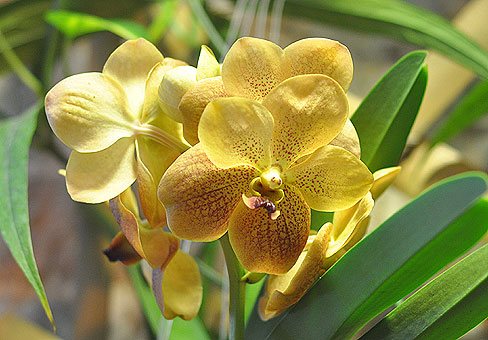

Vanda charles goodfellow
Vanda monster
The variety is obtained by crossing the Vanda tassellata species and the Vanda variety 'Pranerm Ornete'. The plant is a meter or more tall.
A tall peduncle bearing more than a dozen flowers is recommended to be tied or attached to a support.
Vanda Trikim, synonym for Holcoglossum kirnballianum
Homeland - the territory of Thailand and Burma, where the plant is known as Nued-Pram-Lum-Dum. The birthplace of Vanda suavis is Bali.
The variety is obtained by crossing the species Vanda suavis and Vanda kimballiana.
In contrast to the parental species, the variety is characterized by slightly curled petals and a more distinct division of the distal part of the lip into two lobes.
Wanda orchid care
For Wanda, they choose a bright, sunny room with high humidity and a temperature of + 24 ... + 26 ° С during the day and + 14 ... + 15 ° С at night. The exceptions are Vanda coerulea and Vanda kimballiana, which require cooler keeping.
Wands can be placed on windows, mini greenhouses, greenhouses and conservatories. Wandas require more light than Phalaenopsis and Cattleya. The most demanding and, accordingly, difficult in the culture of vanda with cylindrical leaves. They are placed as close to the light as possible.
During cold wintering, kidney loss is possible.
In summer, it is necessary to provide abundant uniform watering with warm water with a low lime content.
During active growth, it is necessary to fertilize every two weeks with a special fertilizer for orchids. The transplant is carried out before the active decomposition of the substrate begins, preferably in the spring. Frequent transplantation is contraindicated, since the root system may suffer. For new plants, a substrate for epiphytes is used.
Reproduction of wanda orchids
Propagated by dividing the bush, while the adult plant is cut in half so that both halves have their own roots. Sometimes in flowering plants dormant buds of peduncles develop into vegetative "babies". They are planted after the formation of their own root system.
They do not multiply with the help of seeds.
Phytodesigner's advice
Light is a limiting factor in the development of this plant: high illumination (up to 30 thousand lux) is required for planting flower buds. For additional illumination, you can use special phytolamps.
Species close to vandas
Aerides
Large epiphytic monopodial orchid. The name comes from Latin aer
—
"Air", which indicates her epiphytic lifestyle. There are about 20 species in the genus, which are easy to cultivate and which are characterized by very fragrant flowers that retain their freshness for a long time.
Popular in culture aerides odorata or fragrant (Aerides
odorata),
the species is widespread in Southeast Asia. Orchids come in a variety of colors from deep pink to white. Albino or white-flowered forms are especially highly valued by collectors.
Aerides hybrids are distinguished by a very wide variety of colors.
Typically, Aerides bloom in spring and summer and prefer bright, intense light. They grow well in hanging baskets.
Arachnis
There are about 6 species of monopodial epiphytes in the genus, growing in Southeast Asia and New Guinea.The name comes from the Latin word arachne - "spider", orchid flowers really look like cute spiders.
These orchids need a very warm, humid maintenance regime and bright sunlight.
Many popular intergeneric hybrids include Aranda (
x Vanda),
Aranthem
(x Renantbera) and a hybrid obtained from crossing three genera:
Mokara
(x Ascocentrumx Vanda).
Ascocentrum
The monopodial genus Ascocentrum is a group of 8 small compact dense leafy epiphytic plants blooming with brightly colored flowers that retain their freshness for a long time. The name comes from Latin askos
—
"Bag" and
kentron—
"Spur", which indicates a large spur on the lip of the flower.
Ascocentrum usually bloom in spring and summer, but in the tropics, large plants can bloom throughout the year. They prefer warm conditions and bright light. Suitable for growing in hanging baskets on sunny windowsills.
Many representatives of the genus and hybrids with their participation are popular in indoor floriculture.
Neofinetia (Neofinetia)
The name comes from the Greek neo - "new", and was given in honor of the French botanist Ashile Finst.
This monopodial genus is found in the cold seasonal semi-deciduous forests of Japan and Korea. Prefers cool to moderate conditions and bright light. With the help of neofinetia, many compact hybrids with fragrant flowers have been obtained.
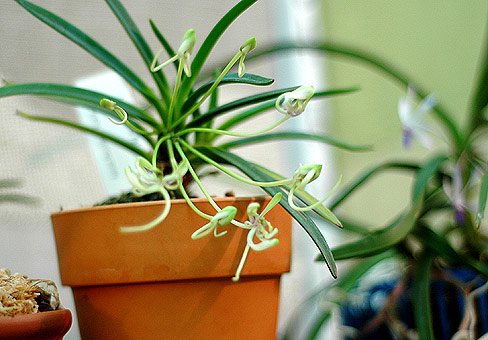

Neofinetia
Renanthera
There are about 15 species of monopodial orchids in the genus, common in Malaysia, Indonesia, the Philippines and New Guinea. Peduncles are tall with lush clusters of flowers. These orchids require warmth and light.
An interesting hybrid Renanthera Monaseng with bright orange flowers, densely mottled with red markings.
Sarcochilus
The name comes from the Greek sarx - "meat" and cheilos - "lip", which indicates the fleshy lip of the flower.
The genus contains about 20 small monopodial epiphytes and lithophytes from Eastern Australia and from New Kaleidonia. They bloom in spring and summer. The flowers open on short stalks and are distinguished by a wide variety of shapes and colors.
Good ventilation and humidity are very important for sarcochilus.
Vanda orchid hybrids with other orchid genera
Aeridovanda
Intergeneric hybrid obtained by crossing orchids Aerides and Vanda (Vanda x Aerides).
The hybrid is distinguished by an erect, long stem bearing two rows of oblong bright green leaves up to 30 cm long. Peduncles emerge from the axils of the leaves and bear multi-flowered inflorescences. The flowers are fragrant, waxy, of various colors, the diameter of the flowers is 2-3 cm. This hybrid grows well and develops with an abundance of light and high humidity.
Aranda
Hybrid obtained from crossing orchids arachnis and vanda (Arachnis x Vanda).
Monopodial orchid with narrow dark green leaves. The peduncle is usually horizontal and contains 5-10 fragrant flowers of various colors. Orchids are often used for cutting. The conditions of detention are the same as those of the wanda. In culture, it is usually grown in pots.
Ascocendra
One of the most popular hybrids, obtained from crossing Ascocentrum and Wanda (Ascocentrum
xVanda).
In culture, the height of plants does not exceed 60 cm. Leaves are lanceolate, leathery, arranged in two rows. The straight peduncle bears a brightly colored, multi-flowered inflorescence-raceme, which contains 12–25 flowers with large rounded petals that retain their freshness for a long time. The color of the flowers is varied. For example, the Ascocenda Pramote orchid is very interesting with orange flowers that retain their freshness for a very long time both on the plant and when cut.
Ascocenda Candy Pink - pink-lilac flowers, 6 si in diameter, peduncle height 55-70 cm, the flower can keep fresh for up to 8-10 weeks;
Ascocenda Cherry Pearl - bright red flowers, shiny;
Ascocenda Highland Gem - flowers up to 7 cm in diameter, bright yellow or orange, peduncle up to 55-70 cm high;
Ascocenda Miami Tangerine - orange flowers with dark specks;
Ascocenda Miss Orange - orange-red flowers, up to 5 cm in diameter;
Ascocenda Suksamaran Beauty - scarlet flower with a small orange eye;
Ascocenda Suksamaran Sunshine is an orange flower, only 2 cm in diameter.


Ascocenda Princess Mikasa Pink
This hybrid does not like excessive dry air, excessive watering and a dense substrate. Feels great in wooden hanging baskets in bright light and prefers warm to moderate conditions. It is very good to grow these orchids on sunny windowsills, provided that the plants are not hypothermic.
Vascostylis
Intergeneric hybrid obtained from crossing ascocentrum, rhynchostilis and wanda (Ascocenda
(AscocentrumxVanda)andRhynchostylis
).
Most of the recorded hybrids of vaskostilis are combinations of ascocenda and rhynchostilis. They are erect plants with belt leaves that grow in two rows. Peduncles bear spectacular flowers, differing in a variety of colors.
Orchids grow well in wooden hanging baskets in bright light and prefer humid, moderate and warm conditions.
Darwinard
(Darwinara)
Complex intergeneric miniature hybrid (Ascocentrum x Ascocentrum x Neofinetia x Rhynchostylis x Vanda - Neofinetia x Rhynchostylis x Vanda). Leaves are dark green, leathery, linear. Inflorescence is a multi-flowered raceme containing 8–12 blue-violet, very fragrant flowers; their diameter is 2-3 cm. The petals are long and thin, the lip is very small.
The plant does not have a dormant period, therefore it requires regular watering and feeding.
ALL indoor orchids
Varieties and varieties
Today there are more than 50 varieties and hybrid varieties of the Vanda orchid, the flowers of which differ from each other in shape and color. The range of colors is extremely varied. Flowers can be white, cornflower blue and blue, lilac and purple, yellow and brownish, pink and crimson. All species and hybrid varieties are characterized by specks, stripes and edging of petals. Some varieties have a faint, delicate aroma.
Exotic indoor flower: rules for keeping and breeding
Illumination
There should be enough light, so the ideal location is southwest and west windows. In this case, direct exposure to the sun causes burns, which can be recognized by extensive brown spots. You can save your green pet if you create diffused lighting and supplementary lighting with fluorescent lamps.
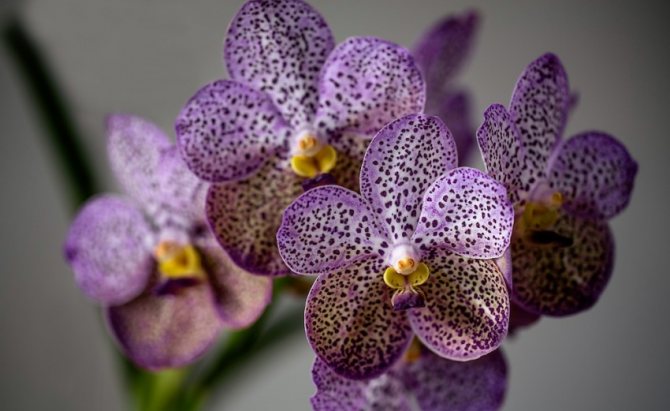

The orchid itself will tell you about the wrong light mode. If its leaves are dark green, then it is worth improving the lighting, and yellowed leaf blades signal an excess of light.
Main types
Wanda roll


This species has a large branched stem, which can reach 3 meters in height, as well as a large number of roots. Rolled leaves reach 20 centimeters in length, and their diameter is only 3 millimeters. On the peduncle there are from 3 to 6 flowers of a fairly large size, so they can reach 10 centimeters in diameter.
Sepals and petals with wavy edges have a rounded or rhomboid shape. The lip (several petals fused with each other) has a three-lobed shape. The wide wedge-shaped central lobe has a purple color, and the side lobes are painted yellow with reddish dots on their surface.
Blooms in October.
Wanda blue
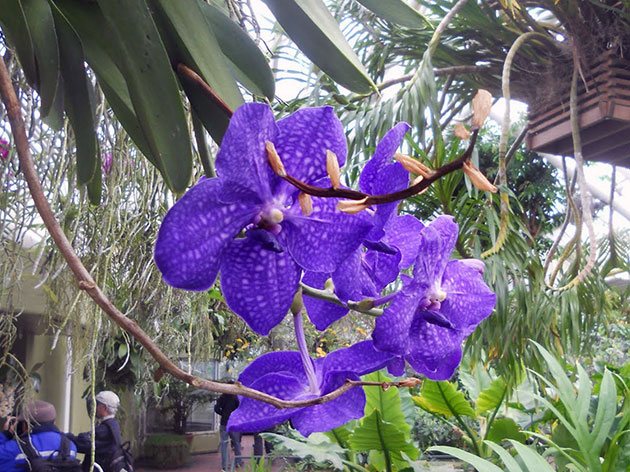

Its straight stem can reach 100 centimeters in height. There are a large number of roots. The toothed belt-like leaves in the upper part have an oblique cut. The racemose inflorescences can be oblique or straight, and they grow exclusively upward. The peduncle carries from 6 to 15 large (up to 10 centimeters in diameter) lavender flowers, and a mesh pattern is placed on their surface.
Wide ovate or cinched sepals taper towards the base. The small lip stands out for its rich color. This plant blooms in October – November.
Wanda tricolor
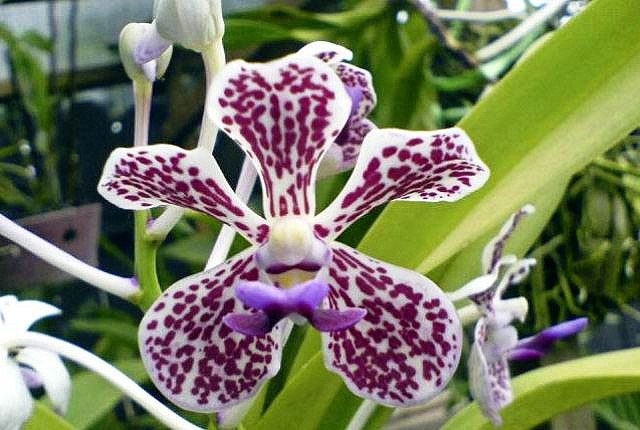

Its straight stem can reach a height of 150 to 200 centimeters. Belt-like long leaves grow in 2 rows.On the peduncle there can be from 7 to 10 fragrant flowers of large size. They are creamy or white in color and have brownish spots on their surface.
Egg-shaped petals and sepals have wavy edges. The claw is wide. The three-lobed lip is similar in size to the flowers. The guitar-shaped central blade is large enough and is colored pink or purple. The side blades are small enough. Such a plant blooms from October to January, as well as in May and June.
Flowering time
The plant differs from other types of orchids by its roots, which are covered with a powerful top layer that forms dead cells. Thereby Wanda gets moisture from the ground and air.
In the wild, the roots that protect the perennial from drying out and burns are about 2 meters long.
From the axils of greenish-gray leaves located on high stems, peduncles appear, on which at least 4 buds are formed, and sometimes even 15... They differ:
- large size;
- amazing aroma;
- various colors.
Important! With further blooming, orchid flowers become brighter, increase in volume, they first appear not earlier than after 4 years.
In the natural environment, Wanda does not shed leaves, it is impossible to determine the period of rest... The plant loves warmth and demands on moisture.
With careful care, an orchid planted in a house or apartment pleases with flowering up to one and a half to two months. But if it succeeds create a favorable microclimate, Wanda releases buds several times a year.
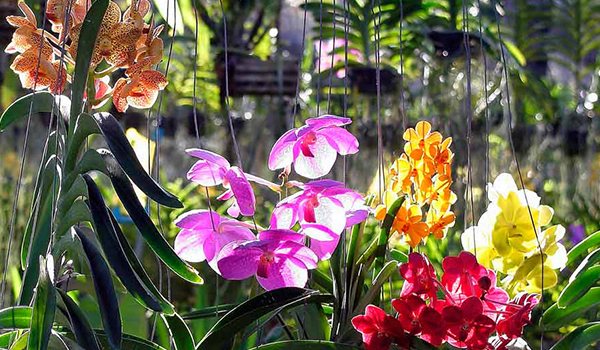

Pests and diseases
Wanda can get sick fusariumif she does not have enough light and watering is carried out incorrectly. Fungal disease affects both the leaves and the stems of the plant.
In its initial stage, dried leaves should be removed. In case of extensive infection, it is necessary to cut off the affected parts of the stems, treat the cuts with coal powder and brilliant green.
Bacterial rot and viruses attack the capricious woman in the warm season. The infected parts of the flower are removed, and the plant itself is treated with fungicides.
Often, pests such as spider mite, thrips and scabbard... In the fight against them, it is not necessary to use insecticides, it is enough to manually clean the plant from insects and their waste products.
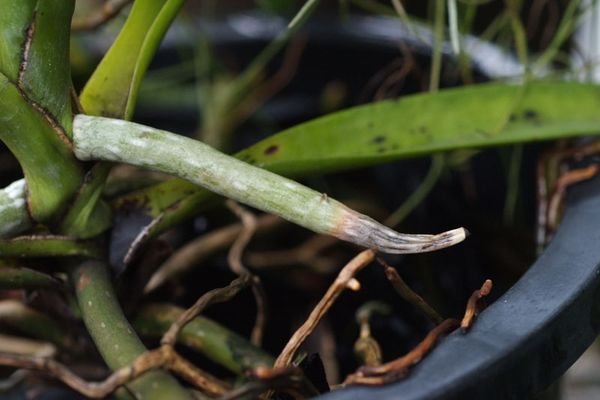

Landing nuances
The Wanda orchid does not tolerate transplantation very well, so the procedure should be carried out only in exceptional cases, for example, if the pot has become too small, or the flower needs to be reanimated if its roots have rotted. It is also recommended to transplant the orchid when the roots are too deeply embedded in the substrate or in the case when the old soil in the container is compressed and dries poorly.
What substrate can you take
In nature, Wandas are epiphytic plants that live on trees. Therefore, the substrate must allow air to flow to the roots and not retain moisture. The optimal soil composition is pine bark and sphagnum moss... These ingredients must be chopped and mixed. Experienced orchidists recommend adding pieces of charcoal, sand and expanded clay to the substrate.
It is very convenient to use a ready-made mixture for orchids, it contains all the necessary components.
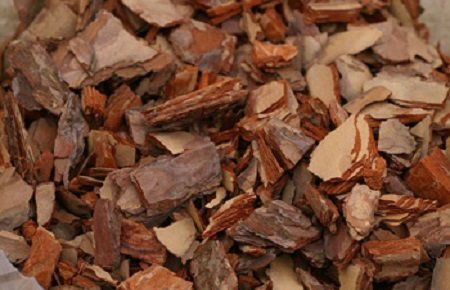

Chopped pine bark is the optimal soil for Wanda.
Some experts believe that Wanda does not need soil at all for the development of Wanda. It can be placed in a plastic basket or simply secured to a piece of bark. Aerial roots will receive nutrients and moisture from the surrounding air.
Pot
Wanda can be grown in a regular clay pot or in a special plastic net. To cover the roots, it can be placed in a flowerpot, a special ceramic flowerpot with a large number of holes on the sides, or in a wicker basket.
Another effective way to grow Wanda is by placing the plant in a glass vase.
Orchid transplant
Step-by-step description of the process:
- Lay expanded clay or gravel drainage in a layer of 2-3 cm at the bottom of the container.
- Spread a layer of coarser bark and sphagnum moss on top of it.
- Remove Wanda from the old pot and carefully clean the roots of the soil.
- Examine the roots and cut out any dry or rotten ones. Sprinkle the slices with crushed activated carbon.
- Place Wanda in a pot and cover the roots in the middle with the finer bark.
- Spread the roots on the sides of the plant and place them behind the walls of the flowerpot.
- After transplanting, do not water the plant for 2-3 days.
Top dressing
Wands are big fans of "eating", but they need to be fertilized only when the orchid is in the active phase of growth. That is, the roots of the plant develop intensively.
The wanda orchid is fed with each watering, but the concentration of fertilizers should not exceed 1 / 8-1 / 12 of the recommended dose. Top dressing is used balanced, marked "For orchids".
When there is enough light and Wanda is actively growing, then it is necessary to feed her regardless of the season. If you fertilize a sleeping orchid, it can lead to the development of diseases and the death of the plant.
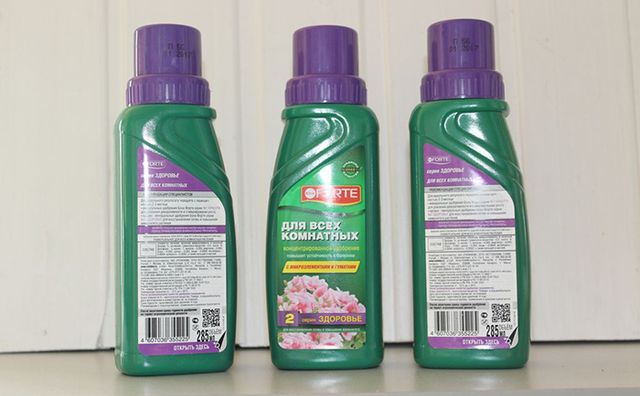

Fertilizer line Bona Forte
Air humidity
The humidity of the air in the life of the wanda orchid is not intended to saturate the roots with moisture. It regulates the connection of sheet plates with the environment. It is required to increase the air humidity in the area of the leaves, not the roots.
An orchid can benefit from 70% humidity in the crown area, as it will force the stomata to open in the daytime, transferring the process of photosynthesis to a different quality.
If the moisture content of the root system is increased to 70%, and 40% remains around the leaves, there will be no acceleration of plant growth.
Description
These orchids are perennial herbaceous plants that grow in humid tropical locations.
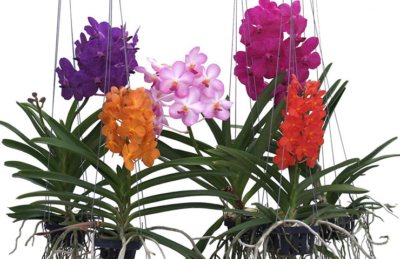

The flower has the following external data:
- Flowers can vary in shape and color. Located on a non-branching stem. The color can be solid or speckled.
- The petals of the flower are located, as it were, in the same plane.
- The stem is cylindrical, the flowers are arranged in two rows.
- Leaves are fleshy or not very fleshy, belt-shaped and ovoid, and intense or bluish-green in color. The thickness of the leaves is due to the storage of water in them. Depending on the variety, they reach lengths from 25-30 cm to 70.
- Due to growth on rocks or host plants, the species has aerial roots (up to 1 m) of a silvery-gray color.
- Inflorescence is a brush. Blooming flowers are still gaining brightness for a couple of days and continue to increase.
If the aerial roots are damaged, the plant will die.
Cut Vandas can stay fresh for up to 2 weeks.
What is the difference from other species?
A huge variety of different types of orchids grow in almost every apartment around the world. Orchid Vanda differs from the "rest" by its wonderful aerial roots, which are able to assimilate water not from the substrate, but directly from the air.
And they are also exceptional for their attractive appearance that adorns any bouquet or interior.
What to look for when buying a wanda:
- The country of origin must be indicated on the label. We do not recommend buying a plant from Thailand, from where these orchids are mainly imported, because Wanda will take a long time to acclimatize in unfamiliar conditions. If the flower was grown to be sold in European countries, then it can be considered sufficiently adapted for living in indoor conditions.
- Specify the name of the wanda, because caring for its varieties may differ.
- Examine the plant. The leaves should be firm, have an even green color, and be free from spots. If they are folded along the central vein and have a wrinkled appearance, then the orchid may be dry and will take a long and difficult time to recover.
- The absence of leaves in the lower quarter of the shoot should not scare you, however, if the stem is half naked or more, then it is better to refuse to buy this specimen.
- The roots should be firm, not broken off, have a slightly greenish or silvery shade. The presence of black spots on them signals rot.
- We do not recommend buying a vanda in the cold season, this will help to avoid hypothermia and possible injuries during packaging for transportation to home.
Reproduction
Flower cultivation
Wanda can be propagated in the spring by cutting off the apical stalk and placing it in a small container filled with a mixture of fern and sphagnum roots for rooting. A couple of days after planting, you can slightly moisten the substrate. The cutting should be watered regularly for 1 to 2 months until it begins to grow. Then you can go back to your regular grooming regimen.
Caring for a tropical plant like the Wanda orchid requires constant attention, time, a lot of effort, and even some sacrifice. You should not acquire such a pet if, due to extremely important circumstances, it is necessary to leave home often and for a long time.
Even when it seems that care can be entrusted to reliable people, it is possible that during the absence of the owner, the whimsical orchid will stop blooming, begin to turn yellow, shed leaves, or simply die. And on the contrary, if Wanda “feels” the attention and love, being in conditions as close as possible to natural, then for many years she will delight those around her with delightful flowering.
Home care for the wanda orchid
The flower requires vigilant attention, paid to its content in constantly high humidity, bright light and warmth.
Placement, temperature and lighting
The optimal place for a wanda in the house is a hanging basket by the window. The plant loves good lighting, the only caveat is that in the period from 12 to 15 o'clock in the afternoon, you will have to take care of protection from the scorching sun if the window is south or west. The vandas placed at the eastern windows do not need shading, and the northern window openings for these orchids are not always suitable, except in summer and provided that they are not located in the shade of trees. In winter, Vanda will need additional lighting with phytolamps so that the daylight hours for it are observed for at least 12 hours.
The temperature in the room where the vanda orchid grows is maintained within the range of 20 to 30 degrees Celsius. If the thermometer readings drop below 20 degrees, the orchid becomes vulnerable to disease. High temperatures of the vanda do not threaten anything, provided there is sufficient moisture. Daily temperature drops are desirable at least 8 degrees, otherwise the plant refuses to bloom.
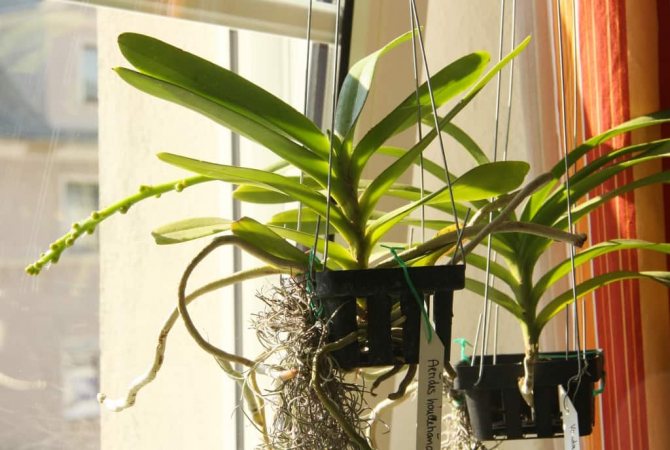

Watering and humidity
Wanda needs daily spraying - this is how the orchid grown in a hanging basket is watered. The water needs to be soft and free of nutrients. The air humidity in the room where the wanda grows is constantly maintained within 70–90%.
Important! Moisturizing procedures for the wanda orchid are carried out only in the morning, so that the roots of the plant have time to dry out during the day.
Many orchivodists turn on a fan to improve air circulation in the room where vandas grow. Immediately after spraying, it should not work, since evaporation from wet roots already cools them, and additional air currents cause the so-called cold burn of the root system. It is not worth turning on the device even when the temperature or air humidity drops.
Vanda orchid in a vase is watered by soldering in warm soft water with a temperature 2-3 degrees above the environment. The container is filled with water for 15–20 minutes, then emptied. During this time, the roots have time to change color from whitish to green, which means that it is enough to be saturated with moisture. A 1 cm layer of water is left at the bottom to maintain the necessary moisture around the roots.If the inner walls of the vase are covered with a green bloom of algae, you must wash them well by removing the plant from the vase.
Attention! Not a drop of water should remain in the core at the end of the shoot after watering and spraying - everything must be blotted with a dry napkin.
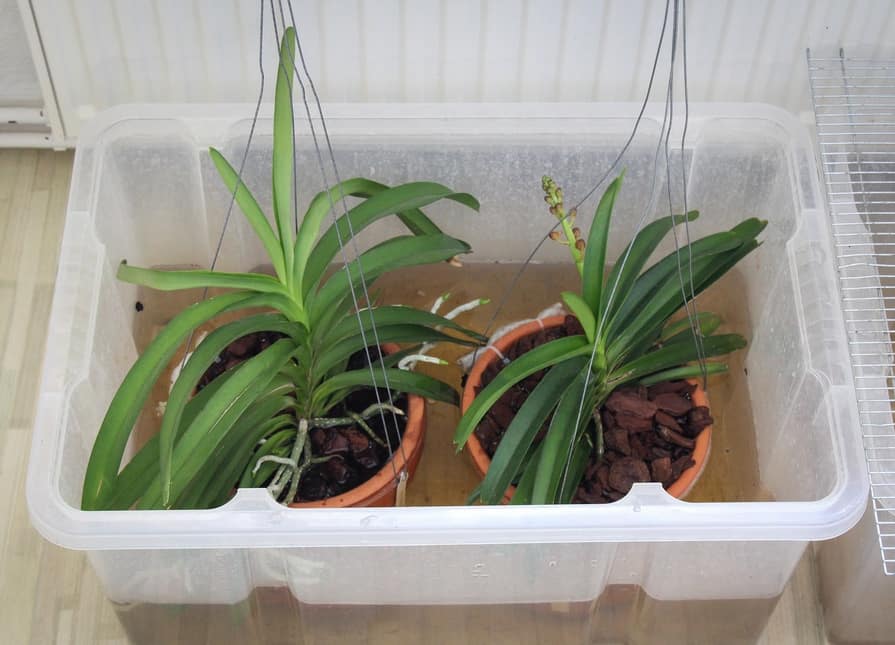

Top dressing
On the issue of fertilizing a plant, flower growers have no consensus. Some consider the Vanda orchid "gluttonous" and from June to November, once every 15 days, "bathe" in a fertilizer solution for 10 minutes, diluted at a concentration of 1 g per 1 liter, and in December and January on the eve of flowering they do not feed it. Others feed before flowering, they believe that adding potassium monophosphate helps to improve budding.
A simple observation can help determine if a vanda orchid is getting enough nutrients. At the base of the new leaf, at the end of the shoot, there is always a light strip of young tissue where it comes into contact with the old leaf. If this strip is less than 1 cm, the vanda receives insufficient feeding, if more - the plant is overfed, finally, with a balanced nutrition, a centimeter width of the rim is formed.
Features of the genus Wanda
Orchids of this genus are distinguished by bright green leaves located on a cylindrical stem. The root system is highly developed. Vanda flower stalks are both low-flowered and multi-flowered. The flowers reach a size up to 15 cm in diameter and are monochromatic and variegated. Coloring from purple and pink to blue and white. Not all Wanda orchid species have a scent.
Vanda orchids are monopodial and do not form a pseudobulb; they grow in height rather than in width. As the stem reaches a medium length, the lower leaves begin to die off.
Temperature
The Vanda orchid cannot be said unequivocally that it is a thermophilic or moderately cold plant. Among the representatives of this species, there are those that grow year-round in warmth and are well tolerated at temperatures of 8-10 ° C.
The genes of each hybrid have their own relation to the ambient temperature. Some grow better in a cool environment, some grow better in a warm environment. To determine the temperature regime of an orchid, you need to find out at what temperature the plant forms the most leaves, roots or flowers.
It is important not to confuse the temperature favorable for growth and the temperature that the plant can simply tolerate.
You can create a temperature of + 40 ° C for the orchid, which the plant will simply survive as unfavorable conditions, but will not form new leaves and flowers. Or you can keep the orchid at + 24 ° C and observe the increase in the number of peduncles and leaves.
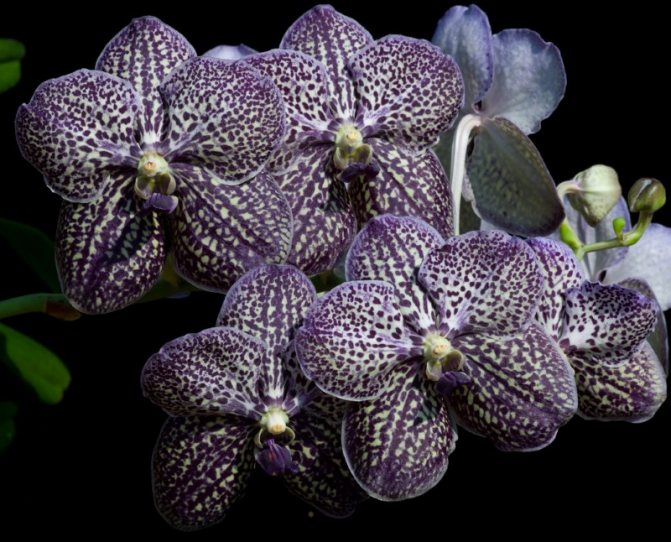

Based on the results of observations of Wanda orchids, it can be argued that the optimal temperature regime for them is the following:
- night temperature not lower than + 14 ° C;
- daytime temperature +22 + 28 ° C.
If we talk about temperatures that can harm plant health:
- minimum permissible temperature +8 + 10 ° C;
- maximum temperature + 42 ° C.
The Vanda orchid, like many other plants, is capable of changing its gas exchange when the humidity drops below 70%. In such conditions, leaf stomata open exclusively at night. It is after the opening of the stomata in the plant that the process of exchange of carbon dioxide is activated, and after it all other vital processes. The following factors affect the rate of exchange of carbon dioxide:
- the intensity of sunlight during the day;
- optimal temperature at night +20 + 22 ° C;
- good ventilation in the room.
Lighting
Among all orchids, it is the genus Vanda that is the most photophilous. This statement is more true for greenhouse plants that cannot be bought in flower shops. As for the zoned hybrids supplied from Holland, their lighting requirements are genetically adapted to our conditions. Such plants can be safely grown on a windowsill.
Content temperature
It should be borne in mind that a store-bought orchid of this species is not 100% Vanda. This name hides a very large group of various hybrids, which in 80% of cases are not pure "Wanda".
Therefore, it is difficult to say unequivocally to which temperature regime a particular plant belongs. It would be more correct to proceed from the averaged values:
- daily maintenance from + 22 ° С to + 28 ° С;
- at night not lower than + 12 ° С;
- temperature difference day / night 6-10 degrees.
This does not mean that Wanda cannot tolerate lower or higher temperatures. It's just that at extreme values, the orchid will not develop: the formation of new cells stops. The survival thresholds for this orchid are + 6 ° C and + 45 ° C.
Ideal temperature for good growth: 24 ... 28 ° C during the day, 20 ... 22 ° C at night.

